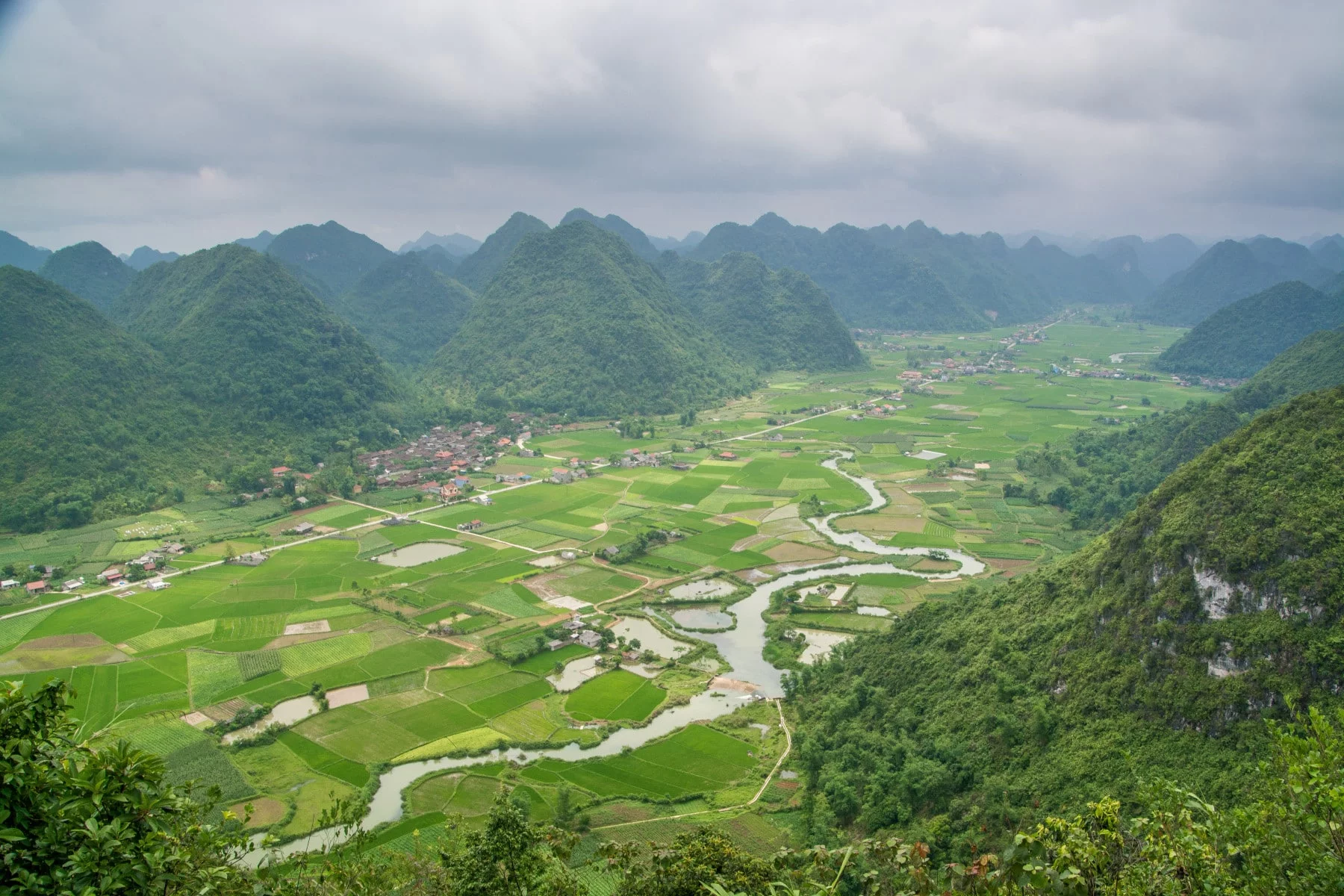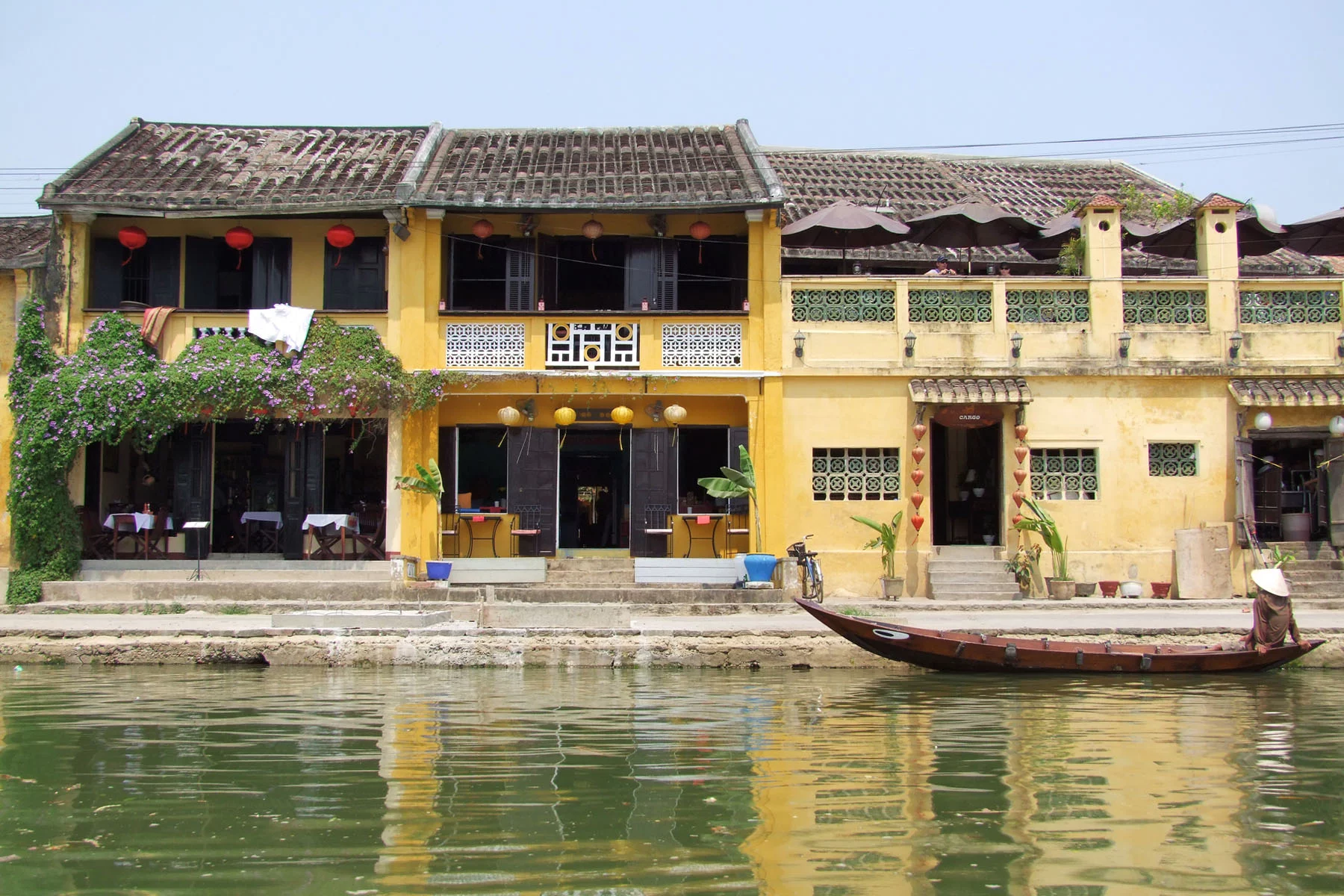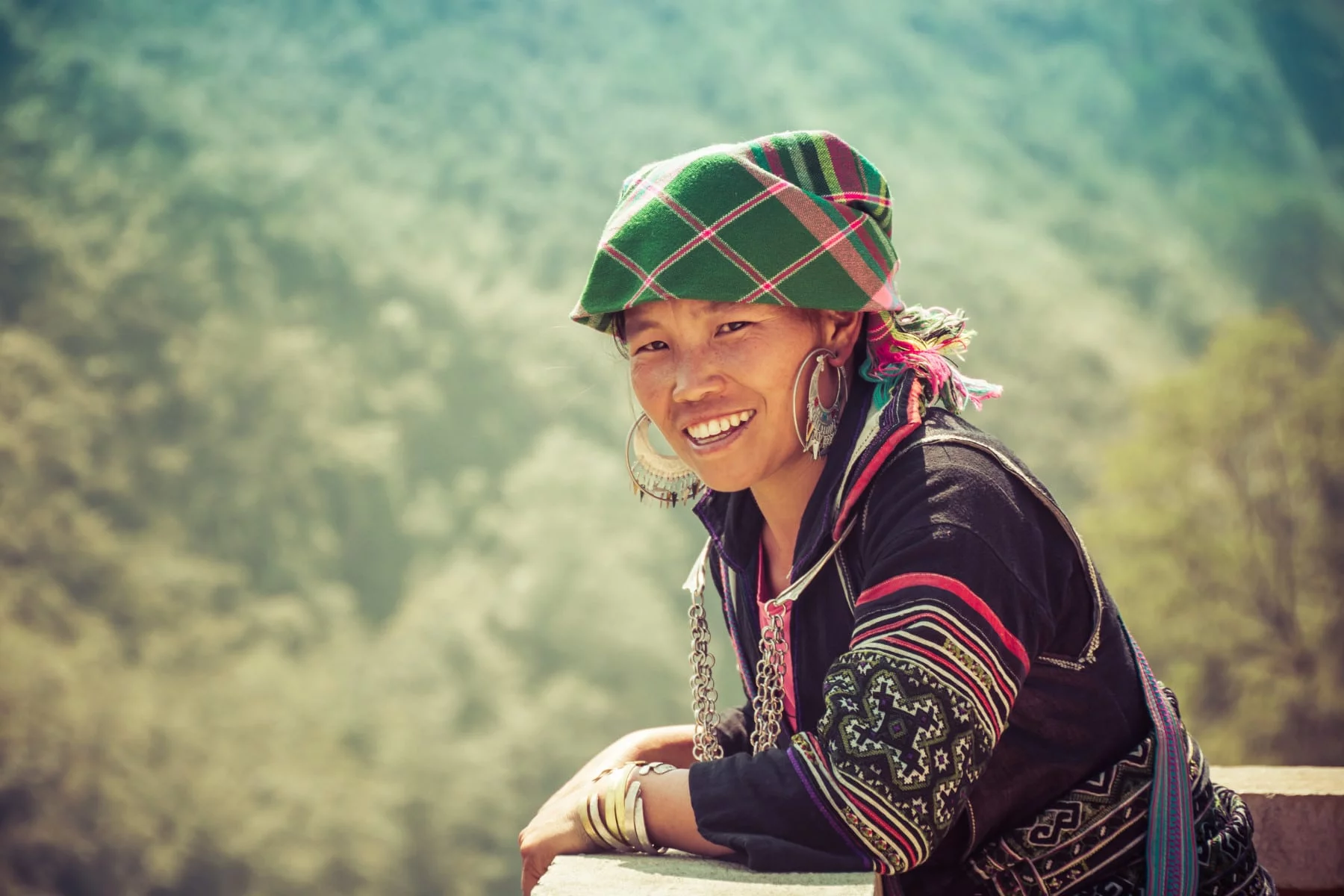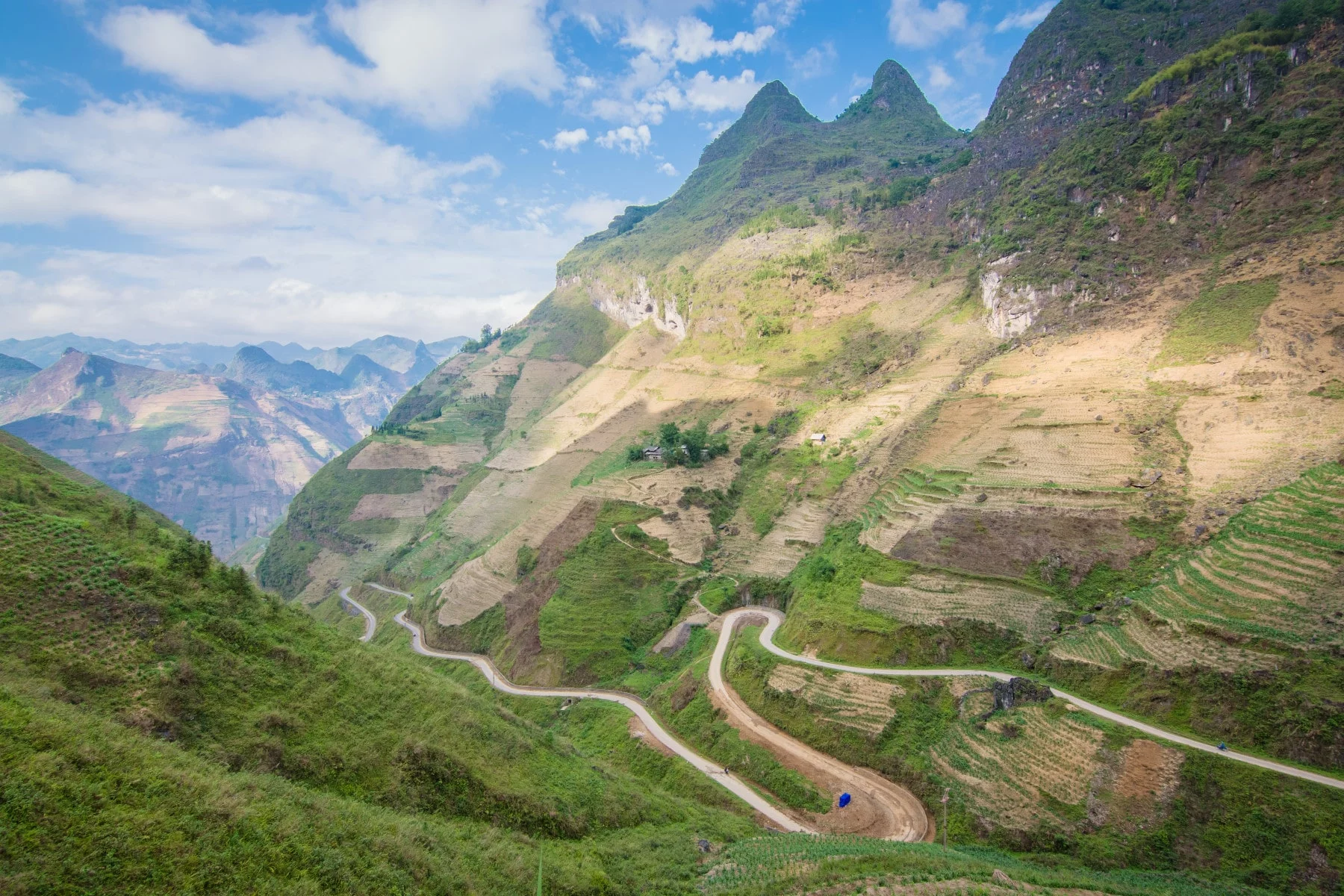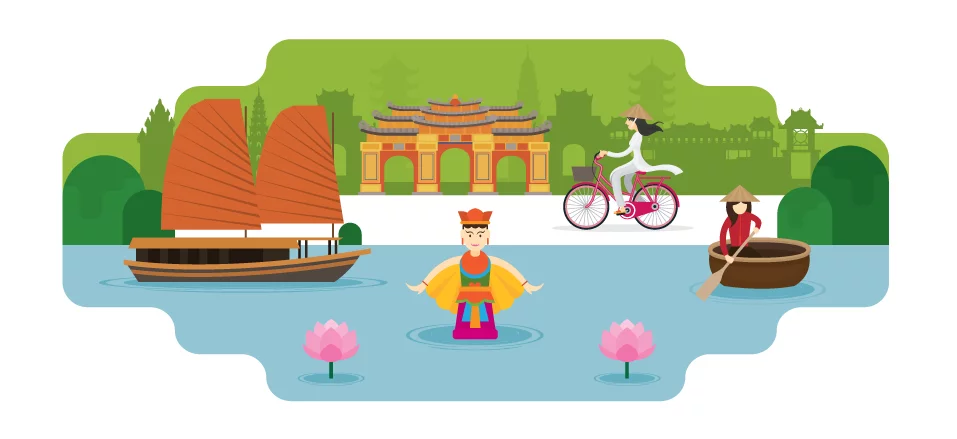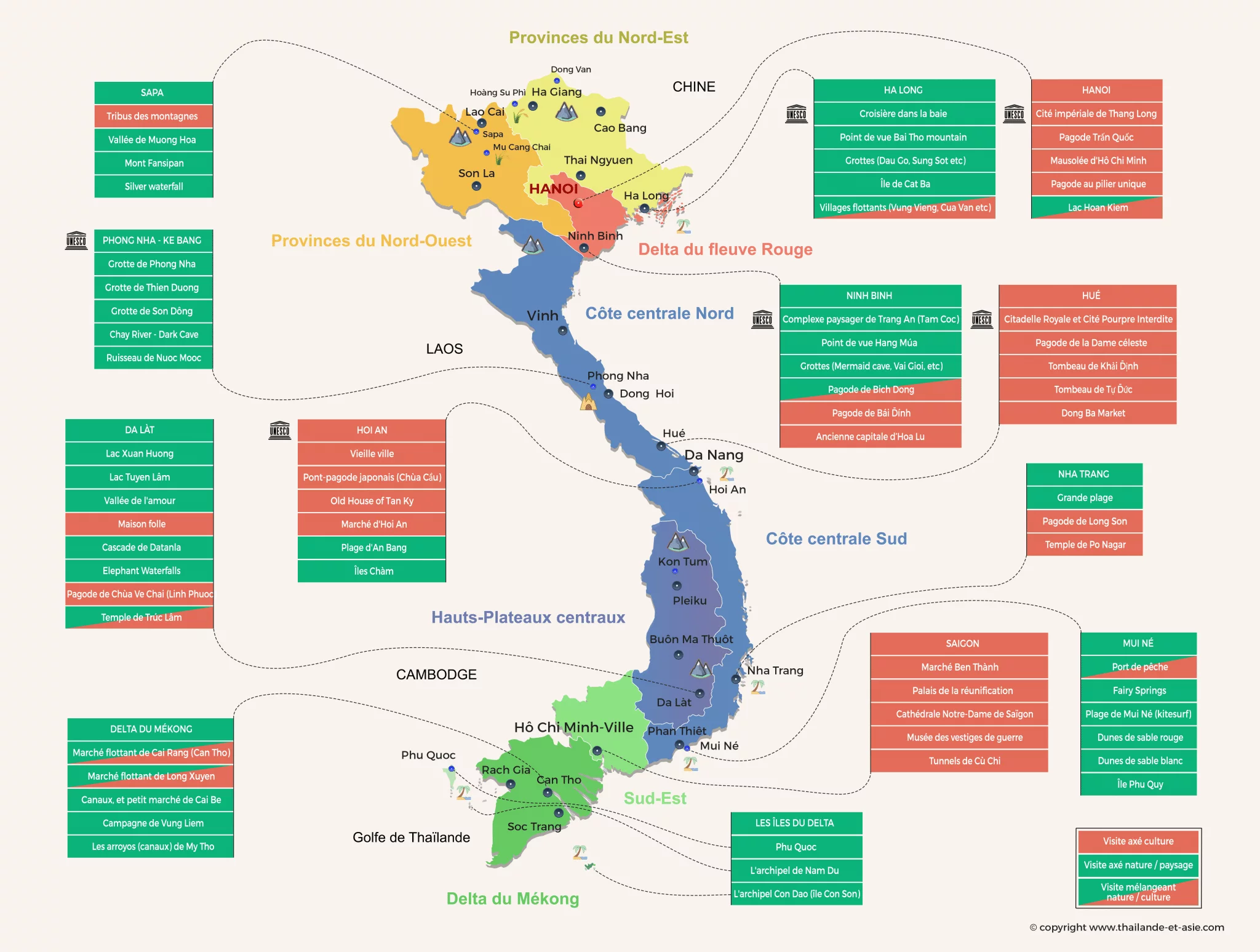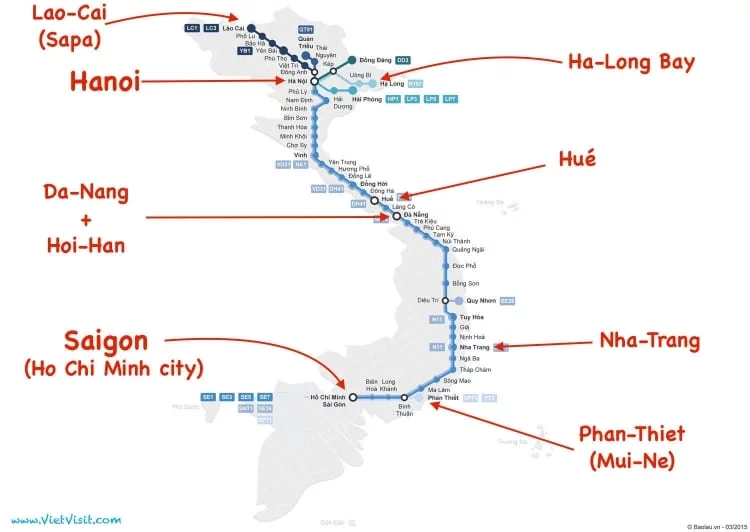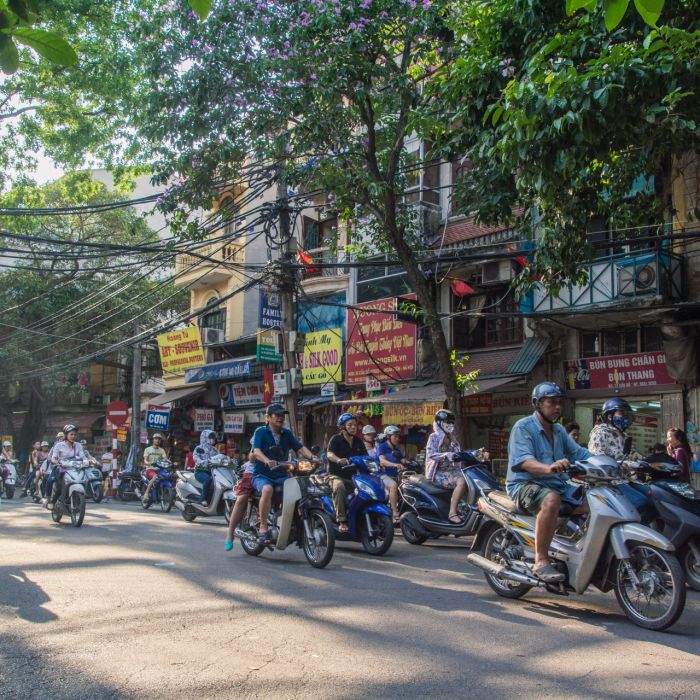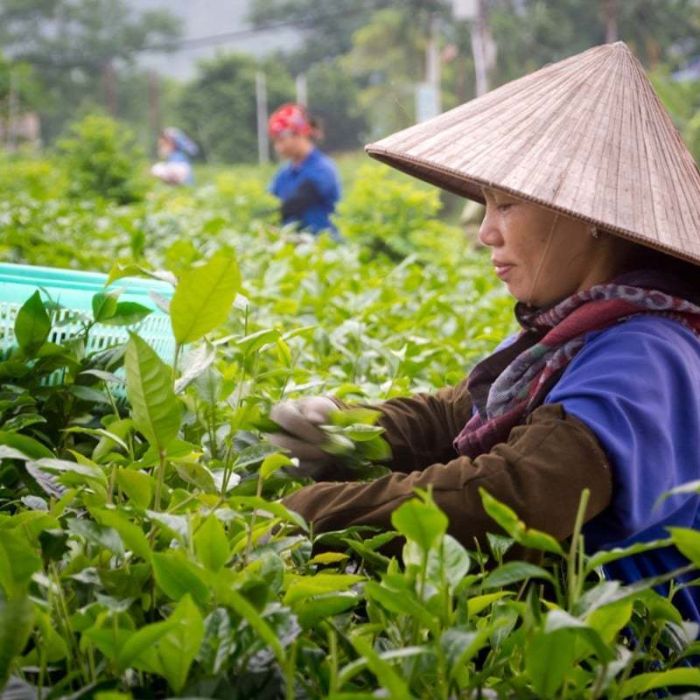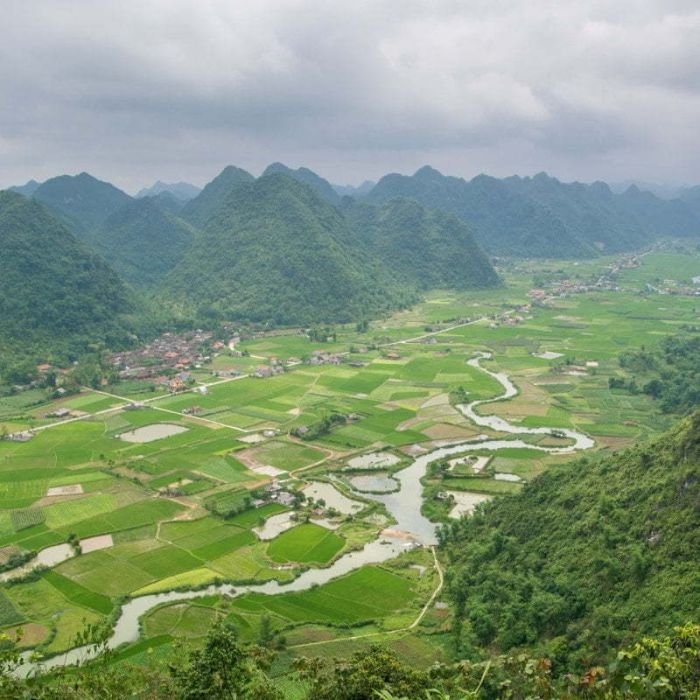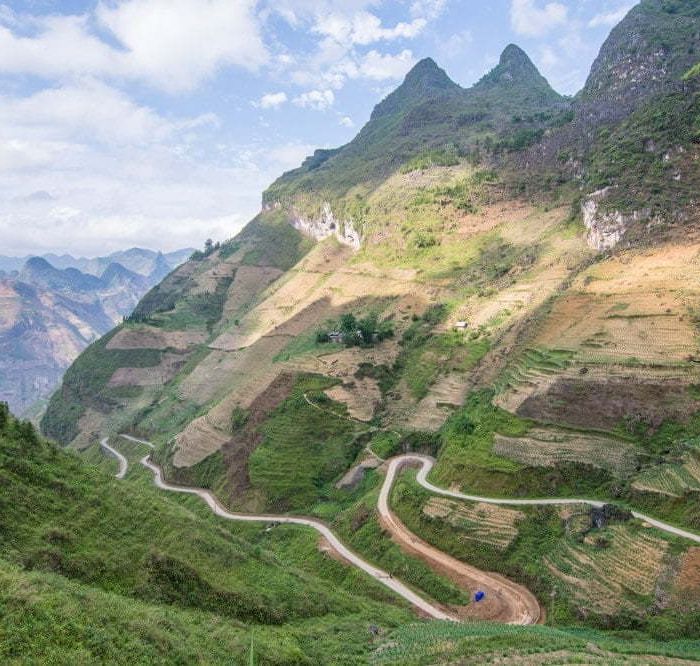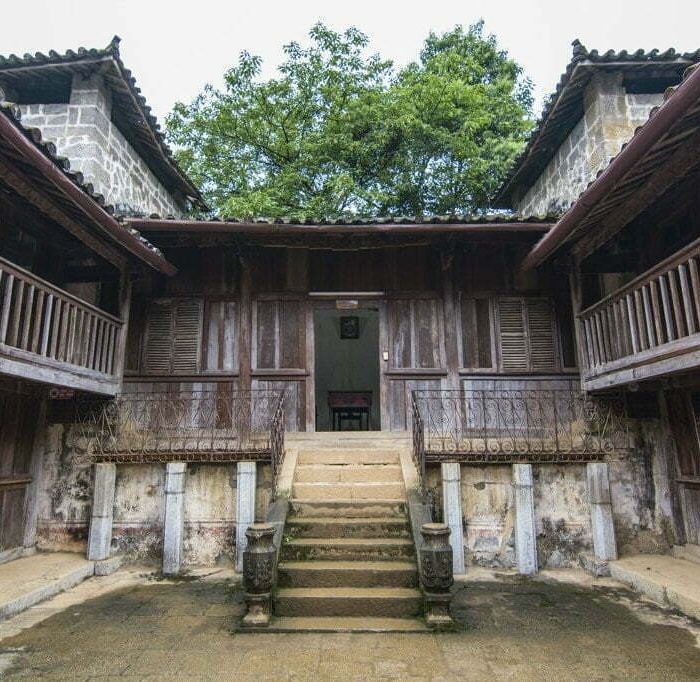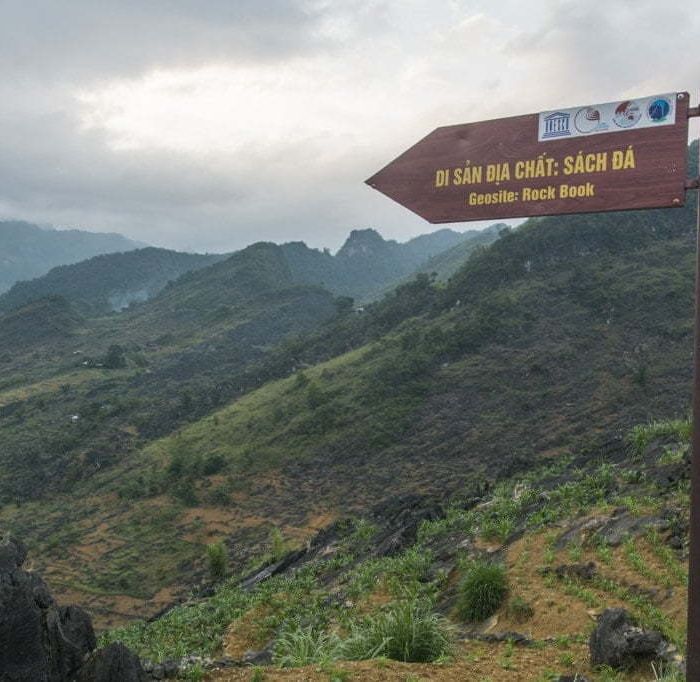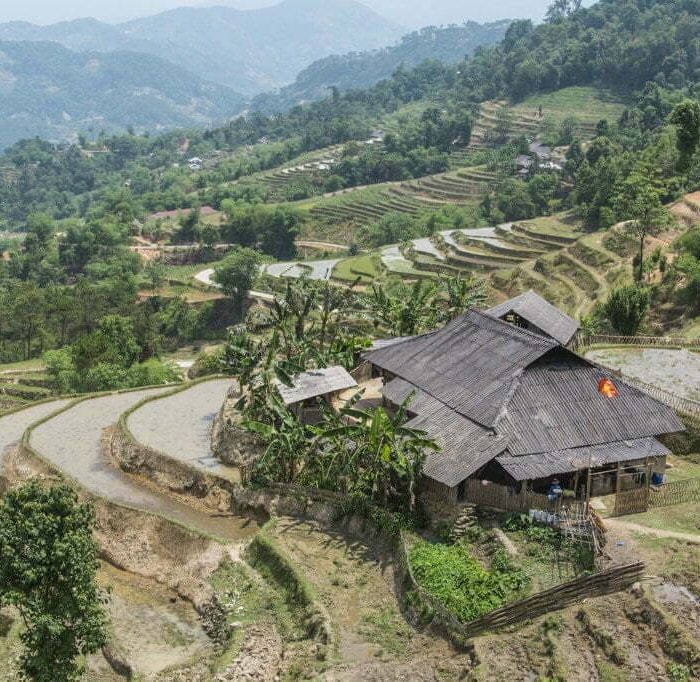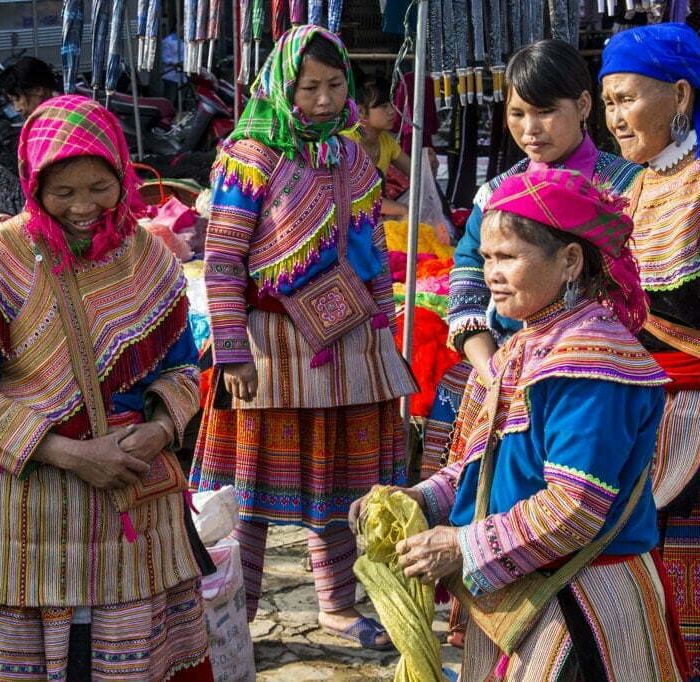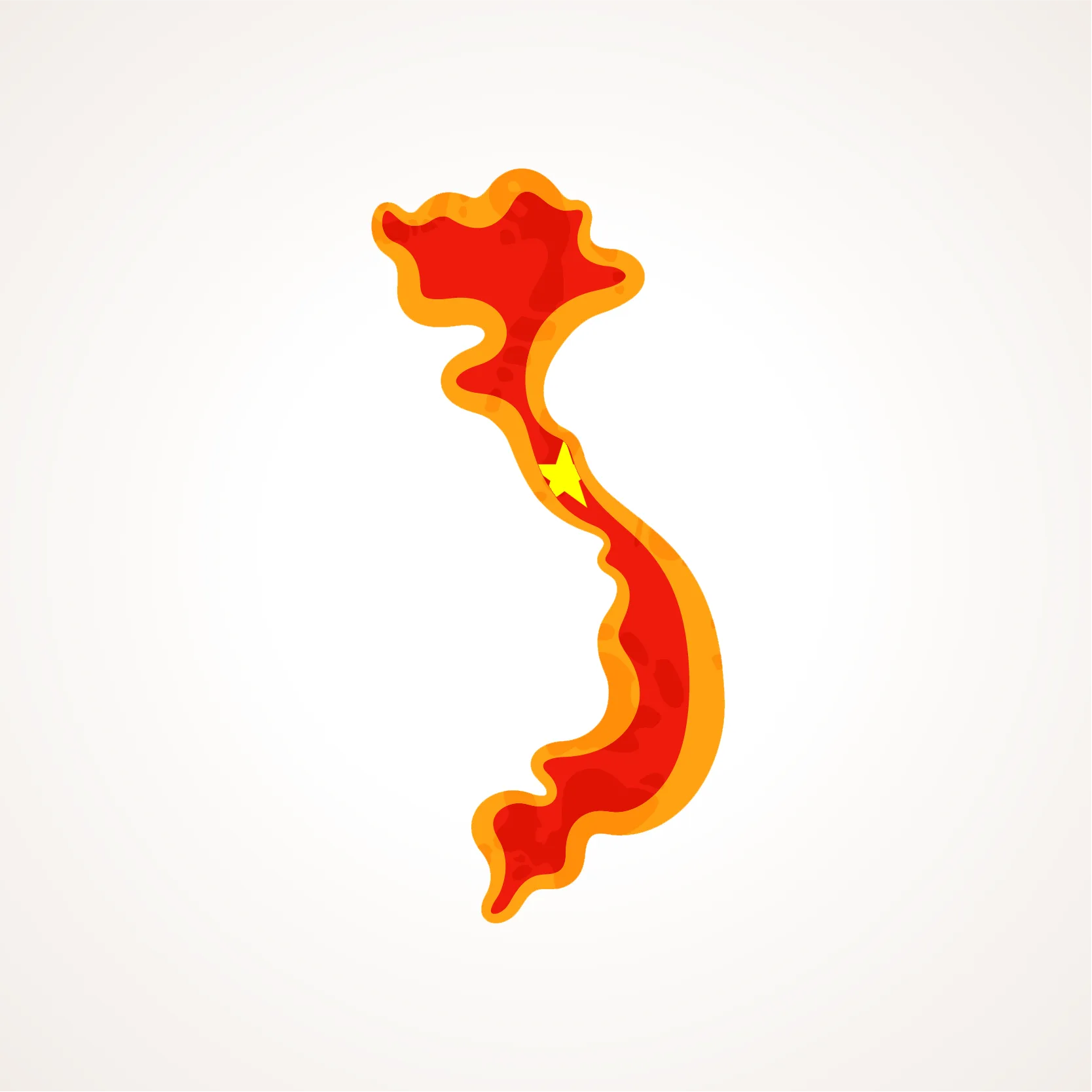Why visit Vietnam?
From the Mekong Delta to the northern mountains, Vietnam boasts terraced rice paddies, karst peaks, and spectacular caves (including Hang Son Doong), with Halong Bay and Tam Coc as iconic landmarks. Over 3,200 km of coastline, islands, and beaches complete the picture.
Vietnam is also home to bustling cities with somewhat chaotic traffic, and to vestiges and a colonial legacy that tell of a difficult past (war, Indochina) that still resonates. Yet the country is moving forward rapidly and becoming increasingly open to travel. While the welcome may seem reserved in some places, encounters are often wonderful, especially in the north.
In short, a major Asian destination, diverse and accessible.
- Diversity and richness of landscapes.
- Easy to organize your stay on site.
- Good food (especially French, but significantly less varied in the north)
- Overall cost remaining cheap.
- The reception was sometimes mixed (especially in the south)
- Road network not always in good condition and chaotic driving.
- Tendency to neglect cleanliness (hello plastic bags lying around).
• Short stays (France, etc.): exemption of up to 45 days At the entrance, passport valid for 6 months.
• Longer period / not eligible: e-visa online for up to 90 days, single or multiple entry.
• Exit ticket & accommodation address may be requested.
• Specific cases or >90 days: embassy/consulate.

3-step e-visa procedure (fast)
1) Submit the application on the Official websiteUpload passport + photo.
2) Choose the longer term, (up to 90 days) and the type of entry (single/multiple) + entry point.
3) You will receive the approval email, print it or keep the PDF on your phone.
Useful special cases
Phu Quoc: Entry **without a visa for up to 30 days** if you arrive on the island and stay there (departing from the island). If you plan to visit the rest of Vietnam afterwards, **obtain an e-visa** from the outset.
Multiple entries: The 45-day exemption does not "cumulative" by leaving/re-entering immediately. For return trips, **prefer a multiple-entry e-visa** (up to 90 days).
Children: Individual passport required; accompanied minors subject to the same visa rules as adults.
Express FAQ
How long before? 2–4 weeks comfort.
Can I change my entry point? Avoid: follow the one indicated on the e-visa.
Extend your stay there? Through an immigration agency; it's safer to plan well in advance.
Climate:
Located in the intertropical zone, Vietnam combines a tropical climate in the south and a subtropical climate in the north. Generally, there is a dry season and a wet season (monsoon), but the rhythms vary depending on the region.
Coast/mountain gaps: At high altitudes, bring a warm layer, especially in winter. For example, in Januaryyou will rarely exceed 20 ° C à Hanoi when Saigon revolves around 32 ° C.
Use the guide below to choose your periods.
The North (Hanoi, Halong Bay, Sapa…)
- Winter (Nov. → Apr.): Cool and dry, sometimes harsh in the mountains. In Hanoi, maximum temperatures rarely exceed 20°C in the heart of winter; snow remains possible on the highest peaks (Sapa).
- Summer monsoon (May → Oct.): warmer and more humid with significant rainfall, peaks in July–August.
Best periods: Nov.–April To visit the towns and the bay; for the mountain rice paddies, aim for the end of the rainy season (end August → October) when the terraces turn green/yellow.
The Center (Huê, Hôi An, Da Nang, Phong Nha…)
- Dry season (Feb. → June): Overall the best window, although some showers are still possible.
- Rainy season shifted (August → January): passages of typhoons possible, especially of Sept. to Nov., with episodes of heavy rain.
Best periods: Feb.–JuneIf you are travelling in the fall, monitor the coastal weather (risk of swell and localized flooding).
The South (Saigon, Mekong Delta, Phu Quoc…)
Warm all year round with two clear seasons.
- Dry season (Nov. → early June): the most pleasant period, peak of good weather Dec.–Apr..
- Rainy season (late June → late October): brief but frequent showers, risk of typhoons surtout August–Oct.
Best periods: Dec.–Apr. for the delta and the islands (Phu Quoc).


When is the best time to visit Vietnam?
To conclude: la best time to visit Vietnam is between February and AprilThe dry season in most regions. The dry season generally extends from November to AprilAvoid if possible August–September, a period of frequent typhoons.
| Region / Month | Jan. | Feb. | Mars | Apr. | Mai | June | Jul. | August | Sept. | Oct. | Nov. | Dec. |
|---|---|---|---|---|---|---|---|---|---|---|---|---|
| North part | OK, fresh | OK, fresh | Ideal | Ideal | mixed | mixed | To avoid | To avoid | mixed | Ideal | Ideal | OK, fresh |
| Centre | mixed | Ideal | Ideal | Ideal | Very hot | Very hot | Very hot | mixed | mixed | To avoid | To avoid | mixed |
| South | Ideal | Ideal | Ideal | Ideal | mixed | mixed | mixed | To avoid | To avoid | mixed | Ideal | Ideal |
Let us summarize here the main attractions of the Vietnam , which can be cut into three major regionsNorth, Central and South (which more or less represent the former divisions of French Indochina, namely Tonkin in the north, Annam in the center and Cochichina in the south).
If we break it down, the official distribution is as follows:
For the North:
- Northeast (where Sapa, Mu Cang Chai, Mai Chau are located)
- Northwest (this includes Bac Ha, Ha Giang, Dong Van, Cao Bang, Bac Son)
- The Red River Delta (which includes Hanoi and Halong Bay or Ninh Binh)
For the Center:
- The North Central Coast (here we find the Phong Nha – Ke Bang National Park and the imperial city of Hue)
- The South Central Coast (which includes Da Nang, Hoi An, Nha Trang and Mui Né further south)
- The Central Highlands (where Da Lat is a popular destination)
For the South:
- South East (Ho Chi Minh City and surroundings)
- The Mekong Delta (Can Tho and Phu Quoc being the main attractions)
The North
While I personally couldn't imagine visiting northern Vietnam any other way than independently by motorbike, there are generally alternatives for visiting on an organized tour via Hanoi or Ha Giang at a minimum, allowing you to optimize your stay.
On the other hand, I see little point in travelling from one city to another simply by bus, because the whole point of the north is the many viewpoints and possible stops to enjoy this spectacular nature.
If motorcycling appeals to you, I've included my article detailing our steps and the information you need to know before embarking on this kind of adventure.
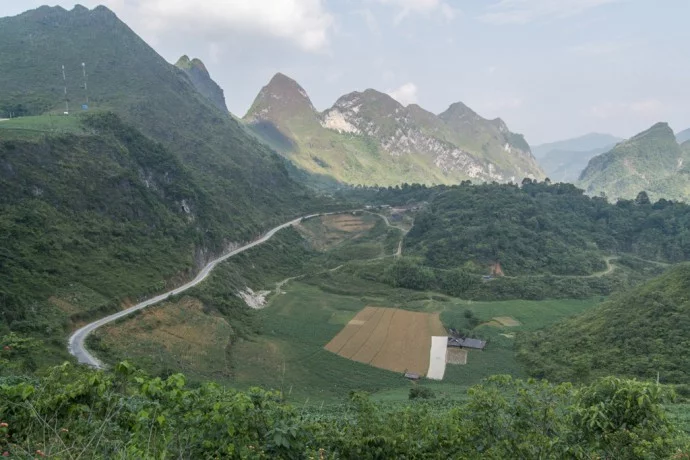
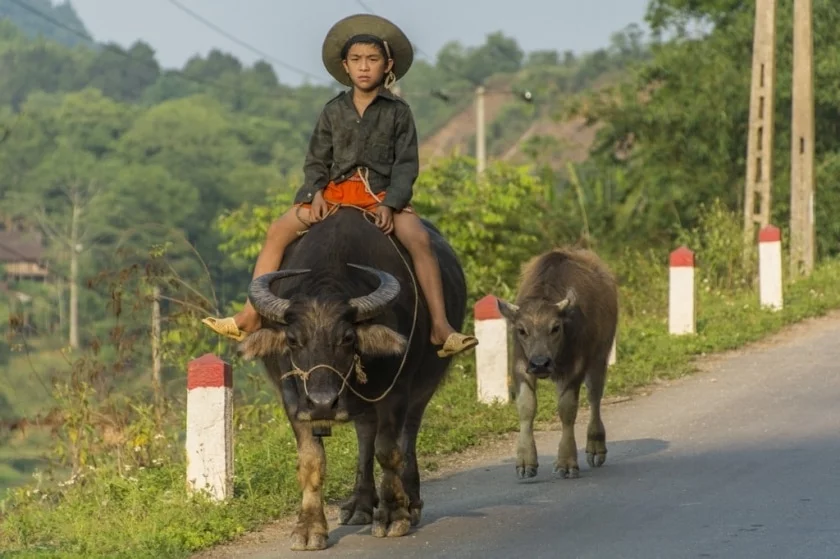
Sapa & Muong Hoa Valley
An iconic gateway to the northern mountains, Sapa is surrounded by stunning rice paddies and Hmong villages. Hiking is possible in the valley of Muong Hoa and climb the Fansipan, the country's highest peak (3,147 m), now accessible by funicular + cable car or via a classic trek.
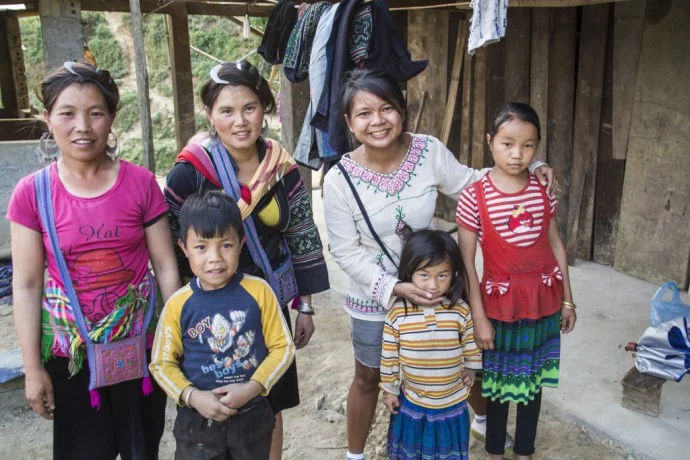
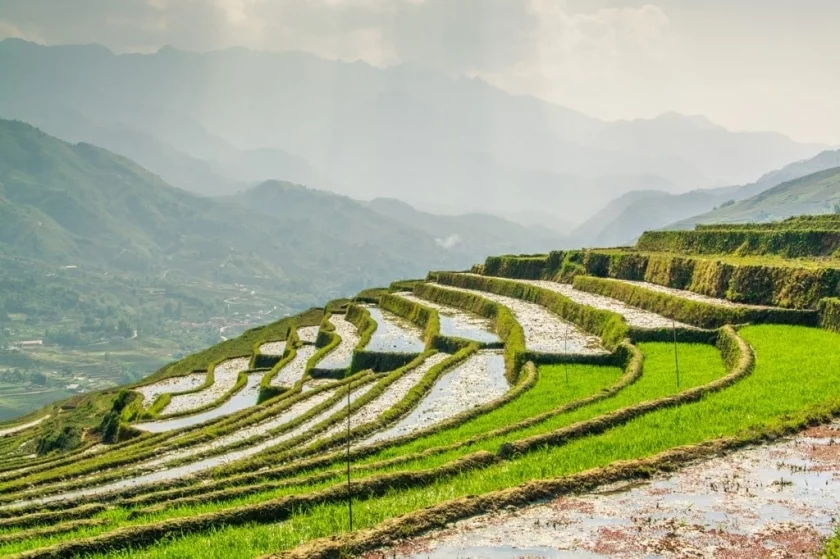
When to go
Best periods: May–June for the verdant rice paddies and September–October for the golden landscapes before the harvest. Winter is cooler and foggier.
Ethical advice for staying with a local resident
Favor local families or guides from the communities, always ask before taking photos, pay your hosts fairly and avoid mass treks.
Mu Cang Chai & Hoang Su Phi
These two regions offer the most beautiful terraced rice paddy landscapes from the country. Mu Cang Chai, south of Sapa, is famous for its spectacular viewpoints. Hoang Su Phi, wilder, combines well with a route towards the Northeast.
Access and duration
From Hanoi, buses connect to Mu Cang Chai in 3.5–5 hours. Hoang Su Phi is often included in a longer loop to Ha Giang and Dong Van.
Mountain markets & villages
Bac Ha Bac Ha is renowned for its lively Sunday market, a crossroads of Flower Hmong, Tay, Nung, and Kinh people. Sunday morning is the ideal time to visit Bac Ha: arrive early to enjoy the light and atmosphere before the tourist buses arrive.
The more rural alternative, Lung Phin It offers a less touristy atmosphere. These markets are perfect for observing local life and buying traditional crafts.
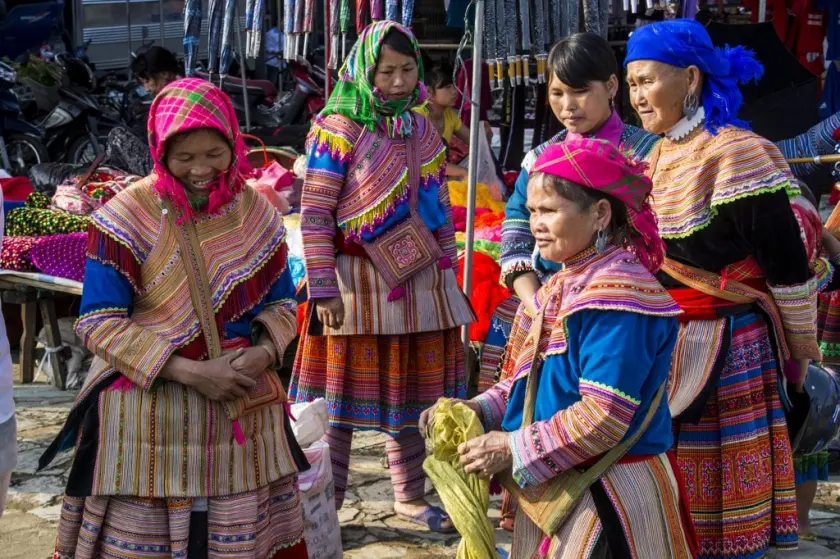
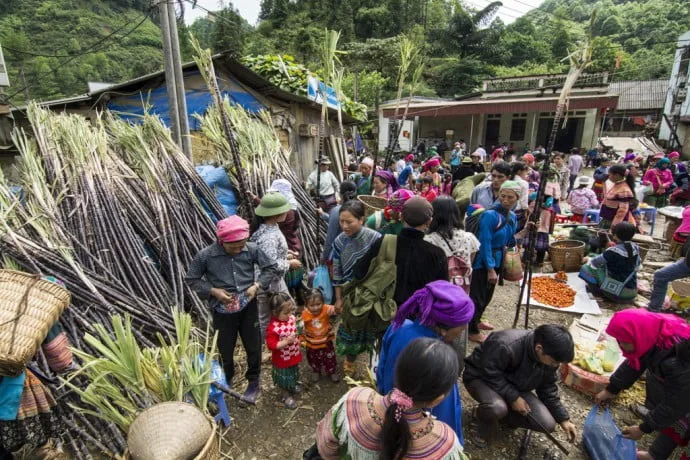
Ha Giang Loop
La Ha Giang loop It crosses the Dong Van karst geopark, a unique mineral landscape dotted with traditional villages. Ma Pi Leng pass, between Dong Van and Meo Vac, is one of the most impressive panoramas in Southeast Asia.
Typically, it's done as a loop starting from the city of Ha Giang. That's basically what we did, except our loop started from Hanoi, so instead of returning to Ha Giang, we continued further south to reach Cao Bang.
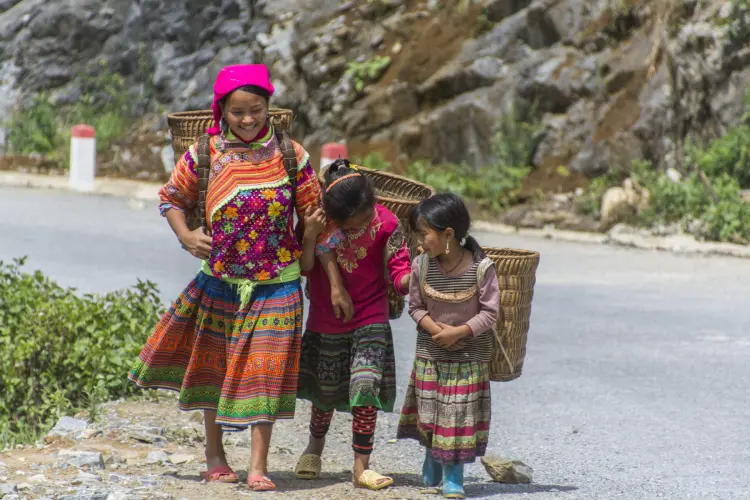
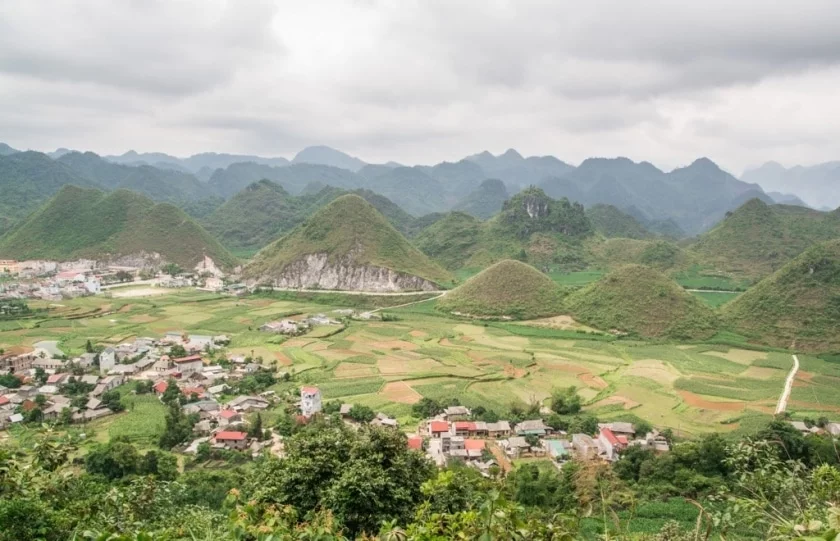
Suggested 4-day itinerary
- Day 1: Ha Giang → Quan Ba (viewpoints of "Fairy Bosom Mountain") → Yen Minh
- Day 2: Yen Minh → Dong Van (old quarter, Hmong king's palace)
- Day 3: Dong Van → Ma Pi Leng → Meo Vac
- Day 4: Meo Vac → return to Ha Giang
It is also possible to do a small local loop from Dong Van, perfect for settling in for at least two nights in the same place.
Hanoi & Red River Delta
À HanoiDiscover the Old Quarter around Hoan Kiem Lake, the Ho Chi Minh Mausoleum, the Imperial Citadel of Thang Long and the One Pillar Pagoda.
Further south, the halong bay It can be visited by cruise (1 or 2 nights), while Tam Coc / Ninh BinhThe "land bay" allows for peaceful navigation amidst karst formations.


Other ideas
- Lai Chau : caves, Thac Tac Tinh waterfall
- Dien bien phu : a historic stop before Laos
- Lake Ba Be Boat trips and limestone landscapes
- Bac Son : spectacular viewpoint overlooking the checkerboard rice paddies


The center
Central Vietnam extends from Thanh Hoa province to Lam Dong province, in the Central Highlands where Da Lat is located.
Despite a width sometimes limited to 50 km, this central strip stretches for more than 1,000 km and concentrates an incredible diversity: spectacular caves, imperial remains, historic cities, charming beaches, volcanic areas and temperate mountains.
It is in this range that we find classic destinations such as the imperial city of Hue, the old town of Hoi An or further south, the seaside resort of Nha Trang and Mui Ne (which I had a soft spot for).
The north central coast
Phong Nha – Ke Bang National Park
Listed as a UNESCO World Heritage Site, the park of Phong Nha – Ke Bang It is home to some of the most impressive caves in the world, including the famous Hang Son Doong, the largest known cavern. Its main gallery reaches 200 m high by 100 m wide and extends for more than 9 km: you could house an entire district of Bangkok in it!
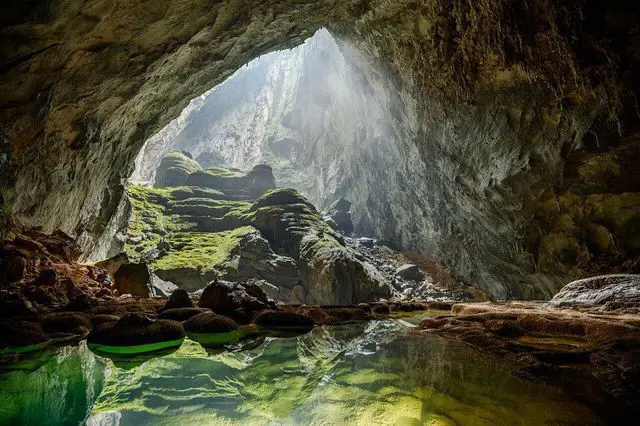
Hang Son Doong: an exceptional expedition
Discovered by chance in 1991 and fully explored in 2009, Hang Son Doong is accessible only via a 4-day expedition with a single accredited company (Oxalis). The adventure combines 17 km of trekking, 8 km of caving, and 90 m of climbing for a cost of approximately €2 700 per person. Bookings open well in advance: the 2026 season is already fully booked, and 2027 is currently underway. The cave is only accessible between February and August.
Other accessible caves
- Phong Nha : the most famous one, which can be visited by boat.
- Thien Duong (Paradise Cave) : a very popular visual marvel.
- Hang Toi (Dark Cave) : caving experience + zip line + mud baths.
- Hang En : 3rd largest cave in the world, accessible via a more affordable trek.
Hue — former imperial capital
Capital of the Nguyen dynasty from 1802 to 1945, Hue preserves an exceptional heritage. The visit begins with the 19th century citadel and imperial palace located in the Forbidden City. Pagoda of the Celestial Lady dominates the river with its six stories, while several imposing imperial tombs complete the visit.
Tombs not to be missed
- Khai Dinh : style blending European and Vietnamese influences, very ornate.
- Tu Đuc : built during his lifetime, in the heart of a 12-hectare romantic park.
The southern central coast
Hoi An & Da Nang
After a possible stopover in the seaside resort of da Nang, you will arrive at the inevitable Hoi AnIts old town, crisscrossed by canals, blends decorated Vietnamese houses, Chinese temples, colorful French colonial architecture, and the famous Japanese pagoda bridge from the 17th century.
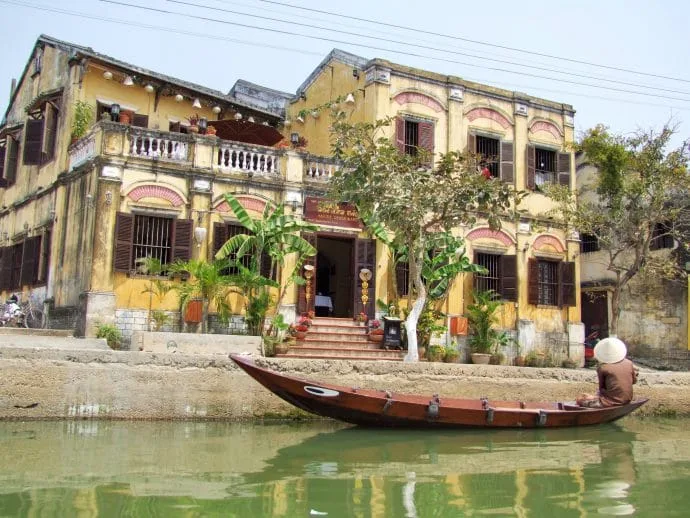
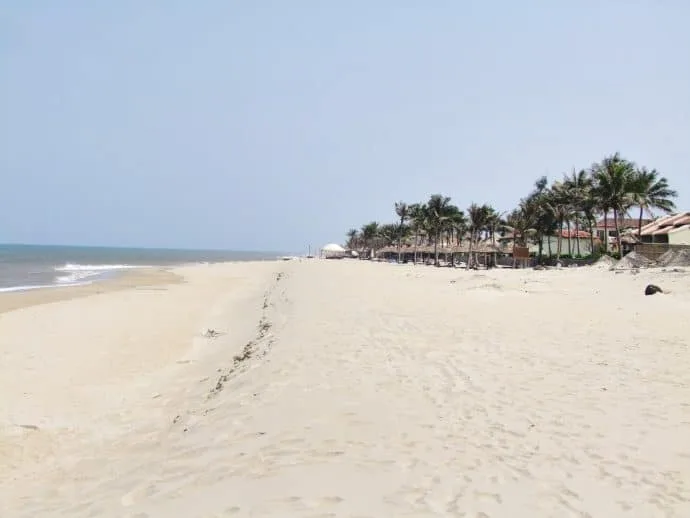
Practical advice
- Stay in or near the old town to enjoy the evening atmosphere.
- The beachAn Bang (5 km) is perfect for a seaside break, Cua Dai is quieter.
- Ferries depart for the Cham islands, about twelve kilometers offshore.
Heading south: islands and beaches
Continuing down the descent:
- Quang Ngai & Ly Son Island : at the port of Sa Ky, embark for this ancient volcanic island with atypical reliefs.
- Nha Trang, : large seaside town with the Cham temple of Po Nagar and excursions to Hon Tre Island.
- Mui Ne A more peaceful resort, known for its beaches, kitesurfing spots, and semi-desert landscapes blending red and white dunes. Not to be missed: the fairy river, a small stream bordered by rock formations sculpted by water.
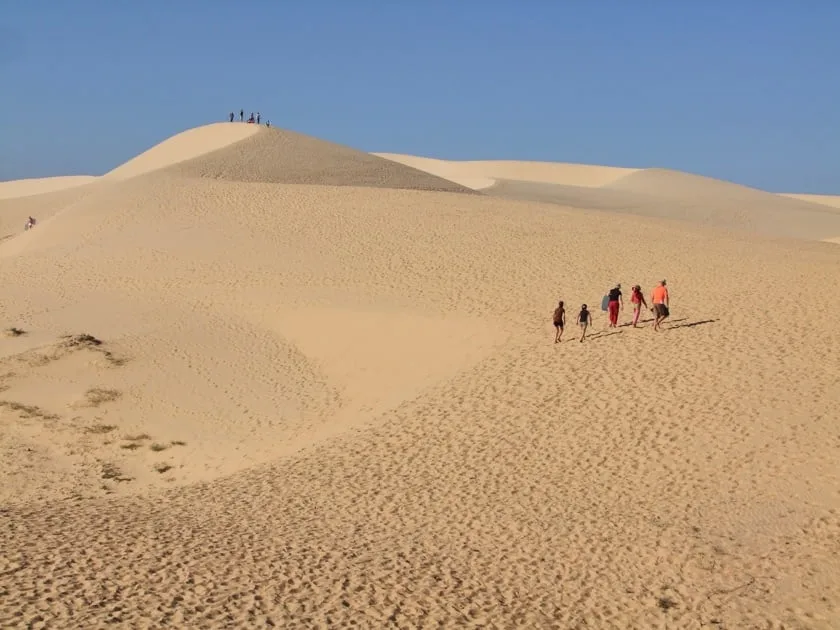
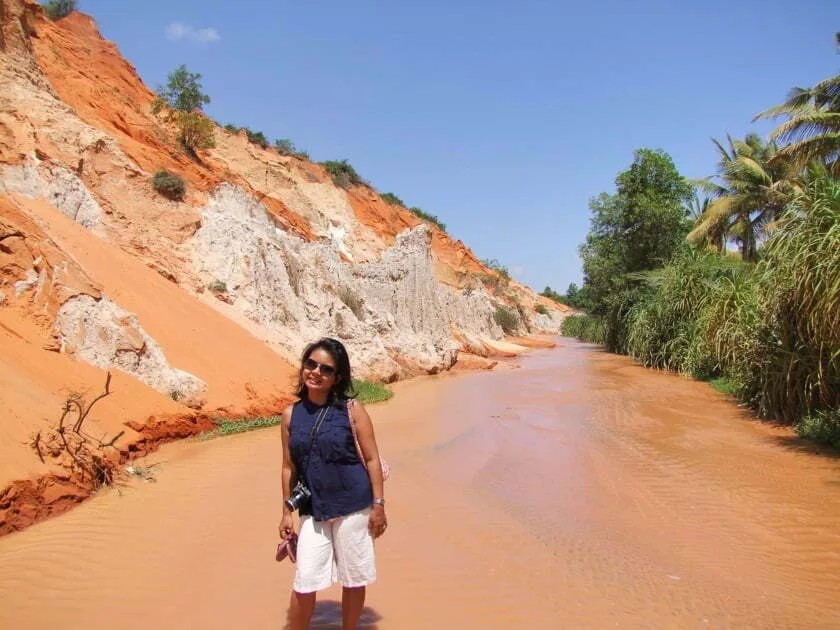
Central Highlands
Inland, the Highlands offer a radically different atmosphere. Located on the border with Laos and Cambodia, this area is the territory of several ethnic minorities such as the Jarai or the Ê Đê, and mixes traditional villages, coffee plantations and spectacular natural landscapes.
- Gia Lai & Kon Tum Jarai villages, forests, volcanic lakes around Pleiku.
- Buôn Ma Thuôt (Dak Lak): capital of Vietnamese coffee, Ê Đê culture, Dray Nur and Dray Sap waterfalls.
- From Lat : the city of eternal spring.
Some places to visit in Da Lat
At an altitude of 1,500 m, From Lat It offers a mountain atmosphere and a mild climate year-round. A former colonial resort town, it charms visitors with its Art Deco villas, European chalets, artificial lakes, and flower-filled valleys. valley of love is one of the city's iconic panoramas.
- Walks around the lakes and flower gardens.
- Waterfalls and natural areas in the immediate vicinity.
- Take a stroll through the colonial city to appreciate its unique architecture in Vietnam.
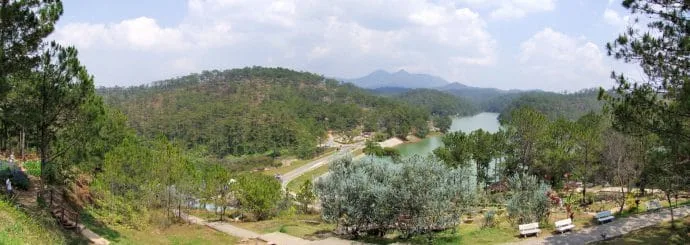
The South (Mekong Delta)
Here we are approaching the south of Vietnam , mainly encompassing Ho Chi Minh City and its surroundings as well as the Mekong Delta area, a legendary river in Southeast Asia.
Ho Chi Minh City and surrounding areas
Formerly Saigon, Ho Chi Minh City is the most populated metropolis in the country and a bustling economic center. It still retains some vestiges of its colonial past such as the Notre-Dame cathedral (built with materials imported from France) or the Central post of the 19th century.
The city was also at the heart of the Vietnam War: the visit of Cu Chi tunnels (an underground network of over 200 km) allows us to measure the resistance strategy implemented by the Viet Minh and then the NLF. War Remnants Museum is another essential step, as instructive as it is poignant.

A must-see in town
- Ben Thanh Market (1914): crafts, textiles and local specialties.
- Reunification Palace : emblematic site of the fall of Saigon (1975).
- Stroll through the colonial quarter for the architecture and historic cafes.
Excursions around the city
- Mangroves of Càn Gio : UNESCO biosphere reserve, accessible in one day.
- Vung Tau : former colonial seaside resort, with a museum in the “white house”.
Mekong Delta
The delta is a vast labyrinth of rivers, canals and islandspunctuated by floating markets, Khmer pagodas, and villages surrounded by rice paddies. The main city is Can Tho, but other locations such as Vinh Long, Ben Tre, My Tho or Cai Be also offer privileged access points.
Cai Rang Floating Market
The Cai Rang floating market is the most famous in the Mekong Delta. To see it at its peak, you should go there between 6 a.m. and 9 a.m.When local exchanges are at their peak, the site becomes more touristy.
Con Dao and the islands off the delta
The archipelago of Côn Đào (French version:) Great Condor) is accessible:
- by ferry from Soc Trang (Tran Đe quay at 1 a.m.), journey of 2 to 3 hours depending on the sea;
- by domestic flight directly on the main island.
Departure from Vung Tau is also possible but not recommended (long overnight crossing by cargo ship).
Islands in the Gulf of Thailand
Southern Vietnam also has islands. The most well-known is Phu QuocLocated just 12 km from the mainland and boasting an international airport, it is developing rapidly, much like Phuket in Thailand, but still retains superb beaches such as Long BeachFerries depart from Hà Tiên to reach the island.

Nam Du Archipelago
Further south, from Rach Giá, you can embark for the archipelago of Nam Duwilder, with beautiful beaches like Bai Cây MênAn ideal option if you are looking for an island atmosphere less crowded than Phu Quoc.
Vietnam in brief
- Sapa: terraced rice paddies, mountains, Hmong villages
- Hanoi: Hoan Kiem Lake, Ho Chi Minh Mausoleum, One Pillar Pagoda, Trấn Quốc Pagoda
- Halong Bay: karst rock cliffs, caves, islands
- Tam Coc (Ninh Binh): "Halong Bay on land", with a famous viewpoint (Hang Mua), caves and temples
- Phong Nha-Ke Bang: national park encompassing caves surrounded by jungle-covered mountains
- Hue: ancient imperial city, tomb of Tu Duc, tomb of Khai Dinh
- Hoi An: Old town (Japanese covered bridge, Tan Ky house, canals), An Bang beach, Cham Island
- Nha Trang: seaside resort with a long beach, the Cham temple of Po Nagar, Hon Tre Island
- Dà Lat: mountain resort with colonial buildings, waterfalls, lakes and gardens
- Mui Né: Beaches for kitesurfing, white and red sand dunes, Fairy Stream, port
- Saigon (Ho Chi Minh City): Ben Thanh Market, Reunification Palace, War Museum, Cu Chi Tunnels
- Mekong Delta : floating markets, canals (Can Tho, Vinh Long, Ben Tre, My Tho)
- Phu Quoc: Vietnam's main island and largest in the country, bordering Cambodia
Vietnam landmarks on a map
Here is a map to locate and summarize all the destinations and places of interest in Vietnam:
Vietnam is the only country in Southeast Asia, apart from Thailand, that we have explored twice.
The first time, we followed a classic route, but in reverse, from south to north, a choice motivated both by the price of plane tickets and by the season, which made this direction of travel more logical.
In just 15 days, it remained a condensed overview, before returning a few years later for two more weeks devoted solely to the North, on a motorcycle road trip — a project I had wanted to realize for a long time.
And even after these two trips, there would still be plenty to consider for a third stay, as there is so much to see!
If you only have one week:
It's very short, but since it's a length of stay I've experienced myself in Thailand, I know that sometimes you might want to get away, even for such a brief period. In a week, there's no question, you have to make a clear choice: North, Central, or South.
In each case, it is possible to combine a few iconic destinations, but without wasting too much time on transport.
"Northern" route — 7 to 8 days
Hanoi (2 nights) → Tam Coc (2 nights) → Halong Bay (1 night) → Sapa (2 nights)
In short: Focus on the highlights of the North: Hanoi for the atmosphere, Tam Coc for the karst landscapes, Halong Bay for the cruise, and Sapa for the terraced rice paddies. This will limit your back-and-forth travel and allow you to spend time at each location in the early morning and evening.
- Hanoi 2 nights — Old Quarter, Hoan Kiem, One Pillar Pagoda.
- Tam Coc / Ninh Binh 2 nights — Boat trip + viewpoints of Hang Mua.
- Halong Bay 1 night — Mini-cruise.
- Sapa 2 nights — Muong Hoa Valley.
If you wish to reduce transport times, you can replace Sapa with Pu Luong, closer to Hanoi (160 km), which also offers magnificent rice paddies.
"Central" Itinerary — 7 to 8 days
Hue (2 nights) → Da Nang (1 night) → Hoi An (2–3 nights) → Phong Nha (1–2 nights)
In short: Central Vietnam combines imperial heritage, coastal charm, and spectacular nature. It's easy to travel between destinations by train or car, while enjoying beaches, old towns, and monumental caves.
- Hue 2 nights — Citadel, imperial tombs (Tu Đuc, Khai Đinh), pagoda of the Celestial Lady.
- Da Nang 1 night — Urban break, beach and Cloud Pass by scenic drive.
- Hoi An 2–3 nights — Old town, Japanese bridge, lanterns; An Bang beaches, Cham islands on an excursion.
- Phong Nha – Ke Bang 1–2 nights (optional) — Accessible caves (Paradise, Dark) or more challenging expeditions.
Plan for at least 2 full nights at Hoi An to enjoy the morning and evening atmospheres without the crowds.
✈️ Da Nang International Airport allows arrival via Hanoi, Ho Chi Minh City or other Asian hubs such as Seoul, Bangkok, Hong Kong or Singapore.
"Southern" Itinerary — 7 to 8 days
Saigon (2 nights) → Can Tho (2 nights) → Phu Quoc or Nam Du (3 nights)
In short: Between bustling cities, floating markets, and tropical beaches, southern Vietnam offers a wonderful variety in a short amount of time. It's the perfect option if you enjoy combining culture, nature, and relaxation.
- Saigon (Ho Chi Minh City) 2 nights — Notre-Dame, Central Post Office, Reunification Palace, War Remnants Museum.
- Can Tho 2 nights — Floating Market of Cai Rang (to be visited early in the morning), canals of the Mekong delta.
- Phu Quoc ou Nam Du archipelago 3 nights — Relaxing on the beach, snorkeling; ferries from Hà Tiên or Rach Gia.
Nature option: add an excursion into the mangroves of Can Gio from Saigon.
If you have two weeks in Vietnam:
Here we're talking about a more typical duration, allowing for a general overview of the country. However, having done it on my first trip, visiting Vietnam from north to south (in either direction) in two weeks is still quite rushed.
In theory, you could also simply combine two one-week itinerary options mentioned just above.
1. North → South Itinerary — 15 days
Saigon → Mui Né → Đà Lat → Nha Trang → Hôi An → Huê → Hanoi → Halong Bay / Tam Côc
In short: A classic 15-day itinerary that offers a great overview of the country from South to North, without the need for flights. You'll travel through diverse landscapes—semi-desert dunes, verdant mountains, ancient imperial cities, karst formations—while seamlessly connecting each stage thanks to trains and night buses.
- Days 1–2: Saigon — discovery of the colonial city, Cu Chi tunnels, Bên Thành market.
- Day 3: Mui Ne — red and white dunes, Fairy Stream.
- Days 4–5: From Lat — mild climate, colonial villas, waterfalls and lakes.
- Day 6: Nha Trang — beach stop + Cham de tours Po Nagar.
- Days 7–9: Hoi An (via Da Nang) — listed old town, lanterns, An Bang or Cai beaches.
- Days 10–11: Hue — Imperial citadel, Nguyen tombs, pagoda of the Celestial Lady.
- Days 12–13: Hanoi — old quarter, Hoàn Kiêm lake, unique atmosphere.
- Days 14–15: Halong Bay or Tam Coc — cruise or boat trip through the heart of the karst landscapes, you'll have to choose…
Timing tip: If you have a few extra days, add a stop in the mountainous North (Sapa or Ha Giang loop) or extend the Halong Bay cruise to 2 full days.
On a map, this is what it looks like:
2. "Northeast by Motorcycle" Route — 12 to 14 days
On two wheels in the Northeast: For this second trip, the idea was clear: to go on an adventure by motorcycle! This economical and flexible means of transport allows you to easily stop for the scenery, to weave through mountain roads and to access less frequented areas.
This journey allowed us to complete two steps that were missed during the first stay: Tam Côc, the "inland Halong Bay", and SapaNext, we'll head towards the North-East, a region that is still relatively untouristed (although it is bound to become more popular over the years) but certainly spectacular, even outside of the rice paddy season.
As it was not the right time for terraced rice paddies, this area seemed more suitable to us than the Northwest, which is more focused on rice-growing landscapes.
Synthetic course:
Hanoi ➔ Tam Côc ➔ Sapa ➔ Bac Ha ➔ Vinh Quang ➔ Ha Giang ➔ Dong Van ➔ Bao Lac ➔ Cao Bang (Ban Gioc Falls) ➔ Bac Son ➔ Thai Nguyen ➔ Hanoi
While we had outlined the general structure of our route, we maintained a degree of flexibility in our program. Ultimately, with a bit more detail, it resulted in this itinerary:
- Jour 1 et 2 : Hanoi (sans nuité) ➔ Tam Coc (2 nuits)
- Jour 3 : Sapa via train de nuit depuis Hanoi ➔ Lao Cai (1 nuit)
- Jour 4 : Bac Ha (1 nuit)
- Jour 5 : Vinh Quang (1 nuit)
- Jour 6 : Ha Giang (1 nuit)
- Jour 7 : Dong Van (1 nuit)
- Jour 8 : Bao Lac (1 nuit)
- Jour 9 et 10 : Cao Bang et la cascade de Ban Gioc (2 nuits)
- Jour 11 : Bac Son (1 nuit)
- Jour 12 : Thai Nguyen (1 nuit)
- Jour 13 : retour à Hanoi (1 nuit)
Normally, this loop, which is fairly typical for this region, ends with a visit to Ba Be Lake, the largest natural lake in Vietnam. Given that we were coming from Cao Bang, going to the lake would have required climbing back into the mountains and therefore taking us a bit further from Hanoi.
Looking at photos the day before choosing our route, the lake didn't particularly inspire us. Besides, I really wanted to see the viewpoint at Bac Son since we weren't that far away, even though we had originally planned to continue further south and not turn west. So, we were looking for one last stop before returning to Hanoi, and in terms of interest and distance, we chose Thai Nguyen for its tea plantations.
It's up to you to choose. Knowing that Thai Nguyen wasn't exactly amazing, but between the so-so weather and the fact that we'd already seen... beautiful plantations in Sri LankaThat didn't help.
If you have a full month in Vietnam:
A month in Vietnam: With 30 days there, you have time to explore the country thoroughly, from north to south, while still leaving some room to relax or extend certain stops. The idea is to start with the cultural capitals and iconic landscapes, then end with a beach break in the south.
Synthetic course:
Hanoi → Halong Bay → Sapa → Tam Côc → Phong Nha → Hue → Hoi An → Nha Trang, → From Lat → Mui Ne → Saigon → Can Tho → Phu Quoc
Detailed pacing idea (≈ 26 nights)
- Hanoi — 2 nights
- Halong Bay — 1 night
- Sapa — 2 nights
- Tam Coc / Ninh Binh — 2 nights
- Phong Nha — 2 nights (caves and nature)
- Hue — 3 nights (Imperial City, Tombs)
- Hoi An — 3 nights (old town, lanterns, beaches)
- Nha Trang, — 1 night (beach break + Cham tours)
- From Lat — 2 nights (mild climate, colonial atmosphere)
- Mui Ne — 3 nights (dunes, Fairy Stream, beach)
- Saigon (Ho Chi Minh City) — 2 nights
- Can Tho — 2 nights (floating market, canals)
- Phu Quoc — 3 nights (rest by the sea)
Coming to Vietnam
There are several international airports offering access to Vietnam. However, as the country is generally visited from north to south or vice versa, the two most likely points of arrival are Ho Chi Minh City in the south, near the Mekong Delta, and Hanoi in the north.
While Hanoi is the capital, Ho Chi Minh City (still known by its former name, Saigon) is Vietnam's largest city. Therefore, it's from there that you'll find the best fares and airline options.
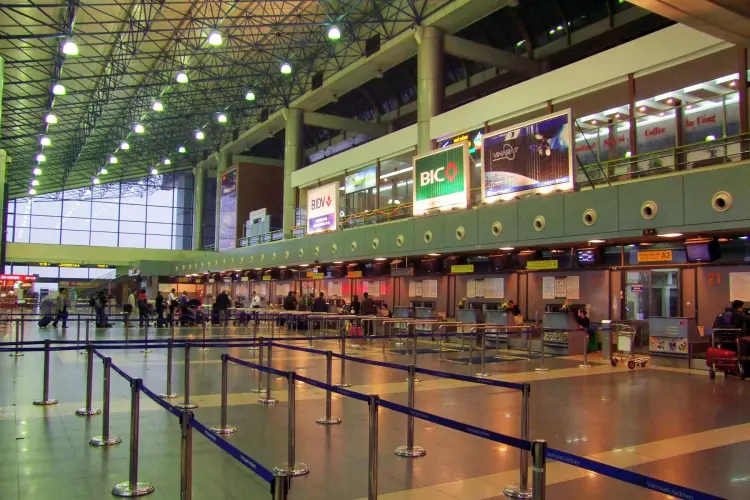
To summarize, your best options for a Paris – Hanoi flight are:
- China Southern, still below €600.
- Qatar Airways, from €617.
- Thai Airways, from €660 with a fairly short stopover in Bangkok (so it's good).
- Emiratesaround €670 but pay attention to the length of the stopover.
- Eva Airaround €720
- Vietnam Airlines850 €, but only the live option.
I mentioned it for Emirates and Thai Airways, but indeed, besides the price, don't forget to look at the journey times; if you see 20 hours and some change, it means the stopover is quite long, so it can be restrictive.

Search for a flight to Vietnam
Getting around Vietnam
The road network wasn't generally as good as in Thailand, but I think that's changed since then. In any case, it's better than its neighbor, Laos.
While the driving style is different from Thailand, it's still chaotic. The major difference lies in the overall speed of the people, much more relaxed and smooth than among the Thais, whose disregard for the traffic laws I unfortunately witness every day (what traffic laws?? Yeah, that was my dig for the day because they're getting on my nerves).
Vietnam is a country where two-wheelers dominate by far, so you will have to put up with seeing them swarming everywhere.
Road transport
On a daily basis, you have four main options: intercity buses (local or "open bus"), taxis / motorcycle taxis / mopeds, private hire with driver et autonomous motorcycleBelow is the essential information, including advantages, limitations, and practical advice.
Intercity buses
Premises Economical, very frequent, purchase at the terminal or via local agencies. Ideal for connecting major cities and regional hubs.
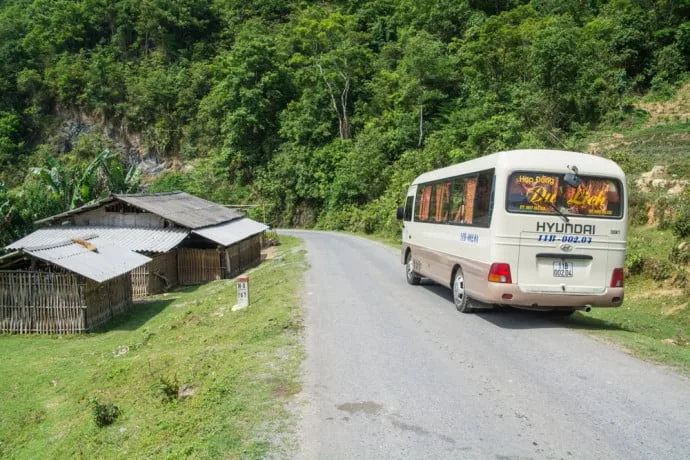
"Open bus" (Sinh Tourist type tourist networks): tickets by segments (e.g. Ho Chi Minh → Dalat → Mui Ne → Nha Trang → Hoi An → Danang → Hue → Hanoi). Benefits : simple booking, central pick-up, flexible dates. limitations : prescribed routes, higher prices than a local bus, unplanned stop charged separately.
Night bus (sleeper) : compact berths, variable comfort (those over 1,75 m tall are often cramped). Bring earplugs/masks, keep your valuables with you, and have large bags tagged in the hold.
- On sleeper buses, prefer the bottom row if you are a light sleeper.
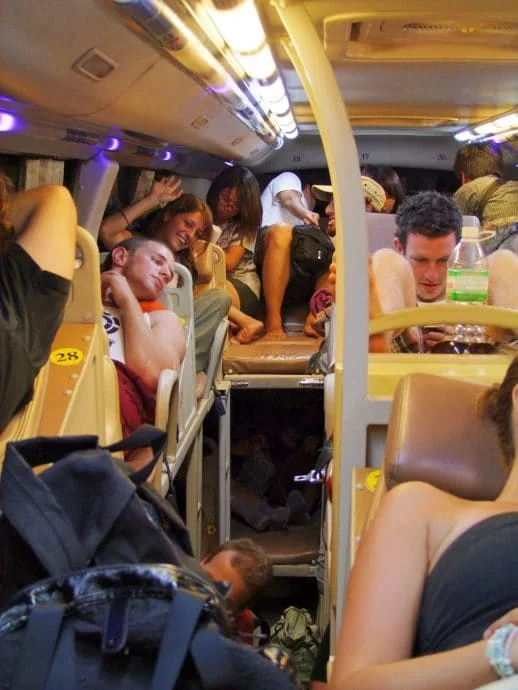
Taxis, motorcycle taxis & cycle rickshaws
In the city, favor the ride-hailing apps (Grab/Be/Gojek) for transparent fares and a planned route. Official taxis at counter remain reliable in the centers.
Motorcycle taxis : very common, fast and cheap for short journeys.
- Activate position sharing when you take a ride-hailing service or a motorcycle taxi.
Cyclo-pousse : more of a tourist experience in the old quarters (Hanoi, Hoi An, HCMC).
Price benchmarks : a short urban journey is often located around 50–120k VND (≈€2–4) depending on city and distance.

Motorcycle & car rental
Car : local driving is dense and unpredictableMany travelers opt for car + driver rather than driving themselves.
Motorcycle (popular) : Helmet required, increased caution (traffic, wet roads, potholes). Permits plan International driving permit (1968 Convention) + national driving permitRespect the usual speed limits (approximately 40–50 km/h in the city, 60 km / h outside built-up areas (except where signposted).
Rental advice : reputable rental company, checks brakes/tires/lights, photos of the conditionfranchise/deposit and assistance clarified.
Expect to pay a minimum of 130,000 VND per day for a Honda Wave (the basic model!), and 220,000 VND for a 125cc automatic scooter.
- Avoid if possible night journeys (animals that can cross), especially during the rainy season (visibility, fatigue).
- There’s nothing quite like a travel insurance Insurance covering the motorcycle (engine size, helmet use, license) is strongly recommended.
Buying/Selling For long stays: possible, but requires the “blue card” of the vehicle. Crossing borders by motorcycle is subject to strict formalities: find out before considering leaving the country.
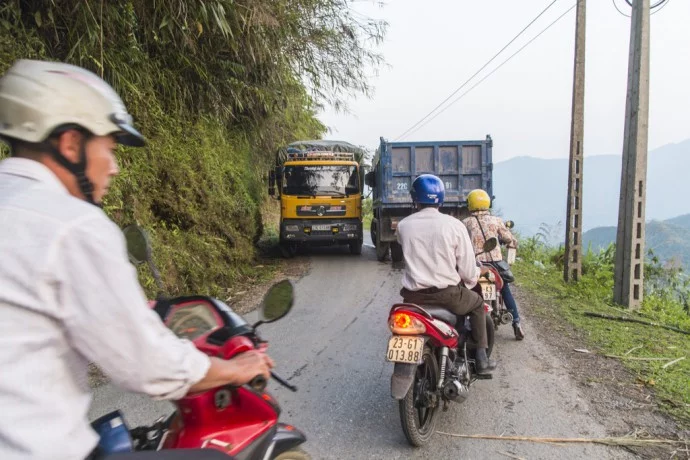
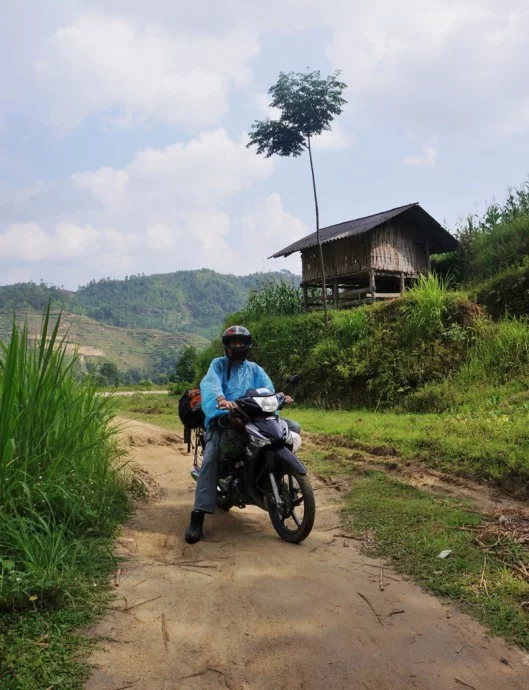
Rail transport
My experience of the train is limited to a journey between Hanoi and Lao Cai to go up to Sapa with our freshly rented motorbike. However, with a line covering 1 km on the main north-south axis (also called the Reunification Line), there is enough to visit a good part of the country with this means of transport. In total, the railway network of Vietnam covers 726 km. For example, it is possible to reach Halong Bay from Hanoi by train, but also Haiphong (to go to Cat Ba Island).
However, you have to take into account that it is a very slow means of transport, with an average of only 40 km/h, yes yes. As a result, to make our journey between Hanoi and Lao Cai, it is 300 km, it takes 9 hours and is therefore done by night train! For a journey from Hanoi to Ho Chi Minh City (Saigon), it takes no less than 30 hours!
Network & travel time: what to expect
• Hanoi ↔ Ho Chi Minh City : approx. 30–35 hours depending on trains and stops.
• Hanoi ↔ Lao Cai (Sapa) : approx. 8–9 hours (mainly at night).
• Hanoi ↔ Haiphong (Halong Bay / Cat Ba via connecting flights): approx. 2–3 hours.
The coastal route between Hue et Da Nang offers superb views (Cloud Pass / Hải Vân).
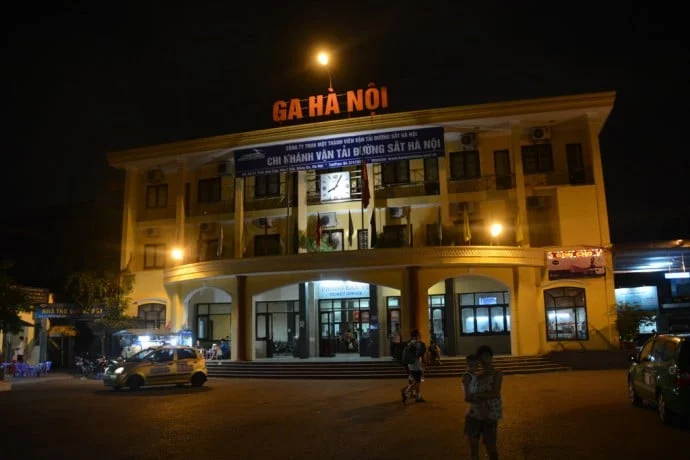
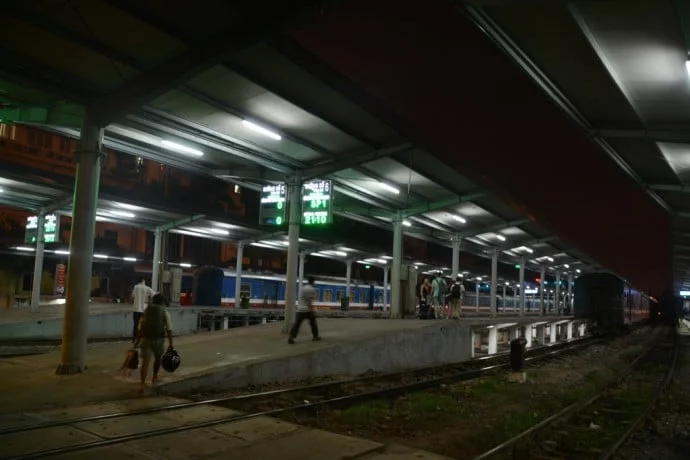
Classes & comfort on board
• Soft sleeper : 4-berth compartment, the most comfortable.
• Hard sleeper : 6-berth compartment, more compact.
• Soft seat : padded seat.
• Hard seat : rigid seat (long distances not recommended).
Private operators equip “passenger” cars (bedding, decor, snacks) on certain routes (e.g. Hanoi–Lao Cai): more expensive, superior comfort.

North-South Line (Reunification)
• Hoi An n / A in your From the train station: get off at Da Nang, then travel by road (≈ 30 km).
• For Mui Ne : trains to Bình Thuân then line/route for Phan Thiet (and Mui Né).
• Major stops: Hue, Đà Nâng, Nha Trang, , Quy Nhon (Diêu Trì), Phan Thiet / Binh Thuan, etc.
Hanoi ↔ Lào Cai (for Sapa)
• Several night trains daily; arrival at Lao Cai at dawn.
• Correspondence by bus/shuttle up to Sapa (≈ 1 h–1 h15).
• Private “tourist” cars available (softer bedding, snacks, decorations).
• The Prices vary depending on class/season; private cars are significantly more expensive than standard carriages.

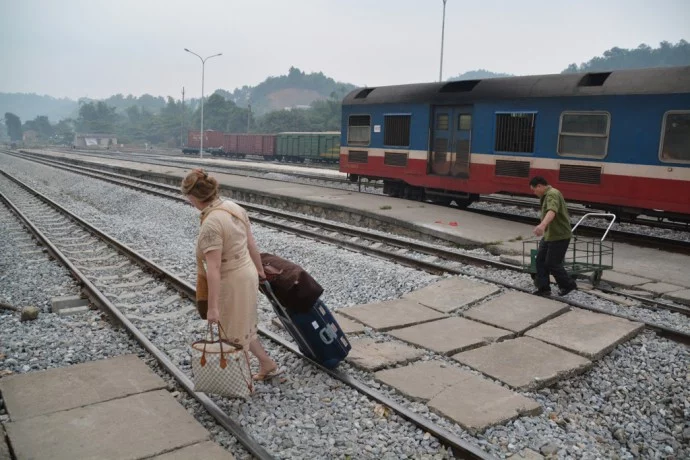
Reservations & tickets
• Purchase at counter train stations, via agencies local or in line (official website/app of Vietnam Railways and known resellers).
• During peak season, book in advance 2–4 weeks the berths in advance.
• e-ticket (QR/PNR) generally accepted; keep your passport within reach for name verification.
• For night trains, choose if possible lower bunk (less rolling, easy access).
Besides the official website, you can buy your tickets online in advance using these two options I'm suggesting. Please note that it's free for children under 6 if they share a bed with a parent, the price decreases for children between 6 and 9 years old, and it's full price for those 10 and older.
The most "classic" option on my blog is 12Go, specialized on transport reservations in Asia. This is a service that has proven itself for transportation in Thailand and Malaysia and is now available for the Vietnam .
In addition to the regular trains of the Vietnam Railways, you will have a choice of private companies such as Livitrans, Violet, Fansipan, Orient Express and Golden Trains. It is normally possible to choose your seat and/or berth in the compartments.
However, reservations are generally only open 60 days in advance. These remain practical alternatives and are better designed in terms of navigation and search than the official website. You will receive an e-ticket that you can print or simply show from your smartphone on site.
Option 1: Buy with 12GB
Option 2: Buy with Baulau.com
Cross-border trains
It's worth noting that it's possible to travel directly from Vietnam to various destinations in China by train. You can reach Beijing from Hanoi via Guilin and Nanning (Nam Ninh in Vietnamese). By changing trains in Nanning and then Guangzhou, you can even reach Hong Kong (allow two nights and a full day to reach the next train, for a total of three days). There's also a train connecting Kunming to Lao Cai, an extension of the Hanoi-Lao Cai line.
If you have time, you can even take the trip further since it is possible to do a London → Hanoi in 2 weeks by rail, using a good part of the famous Trans-Siberian, this is done in 3 stages:
- Step 1: London to Moscow. Several options are available, via Brussels, Cologne, and Warsaw, as well as via Berlin, which then offers a direct connection to Moscow. Daily departures, minimum 2-night stay, from €300 one-way with a sleeper car.
- Step 2: Moscow to Beijing via Trans-Siberian Railway. Two trains per week, 6 nights, from €500 one way with a 4-berth sleeper car.
- Step 3: Beijing to Hanoi. Two trains per week, 2 nights, around €200.
The subways
Metro in Hanoi
The work has been ongoing for over 10 years… In Hanoi, there are 8 lines planned by 2030. But to date, only two lines are open.
- Line 2A Cát Linh–Hà Đông is in service (12 stations, ~13 km).
- La Line 3 Nhan–Hanoi Station opened its aerial section (Nhân ↔ Câu Giây) and the underground extension towards the station remains under construction.
Map & info: site of Hanoi Rail Transit.
Metro in Ho Chi Minh City (Saigon)
Line 1 (Bên Thành – Suôi Tiên) Opened for commercial service on December 22, 2024, it connects the city center to the Thu Đuc (Suôi Tiên) area. Other lines are also planned for the coming years.
Map & info: site of Ho Chi Minh City Metro.
Shipping
With over 3 km of coastline, it goes without saying that the boat is a significant means of transport in Vietnam. If we only count the Mekong Delta area, offering several maritime "routes" and these numerous islands in the south of the country in particular, the ferry makes perfect sense.
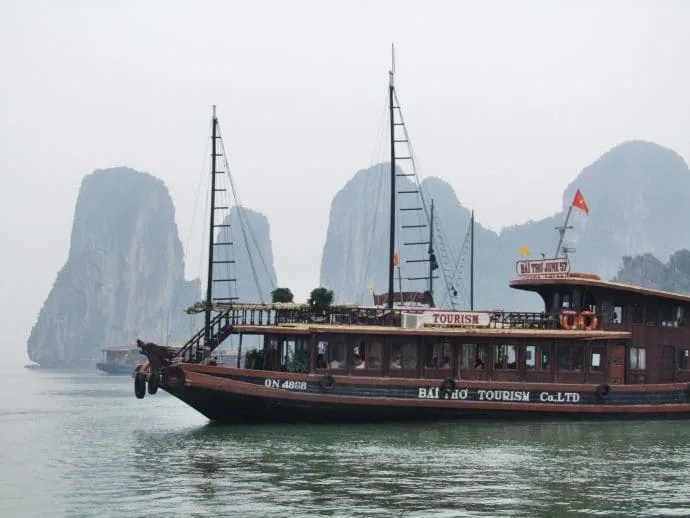
North — Ha Long Bay & Gulf of Tonkin
- Hai Phong ↔ Cat Ba Island : ~1 hour by speedboat (frequent connections).
- Tuan Chau ↔ Cat Ba : ~1 hour 30 minutes (tickets on site).
- Ha Long (Hon Gai) ↔ Quan Lan Island : ~1 h15.
- Cai Rong (Van Don) ↔ Quan Lan : ~45 min.
- Cai Rong (Van Don) ↔ Co To Island : fast (speedboat) or slow (ferry ~4 hours).
Central — Hoi An & Central Coast
- Hoi An (Cua Dai) ↔ Cham Islands : 30–45 min by speedboat (~400,000 VND) or ~2 h by public ferry (≈150,000 VND + entrance fee ~70,000 VND).
- Quang Ngai (Sa Ky port) ↔ Ly Son island : 1–1 h30 (~95,000 VND).
South — Mekong Delta & Gulf of Thailand
- Ho Chi Minh City ↔ Vung Tau (Greenlines DP): ~2:15–2:30. The journey can sometimes be rough; choose a calm sea.
- Soc Trang (Tran De) ↔ Côn Dao : ~2 h (speedboat).
- Vung Tau ↔ Côn Dao : overnight cargo ~12 hours (seat or berth).
- Phan Thiet ↔ Phu Quy island : variable rotations, tickets often available on site.
- Ha Tien ↔ Phu Quoc : ~1 h20 (~230,000 VND).
- Rach Gia ↔ Phu Quoc : ~2 h30 (~230,000 VND).
- Rach Gia ↔ Nam Du (via Hon Son): ~2h30 (~210,000 VND).
- Rach Gia ↔ Hon Son : ~1 h30 (~230,000 VND).
- Rach Gia ↔ Hon Tre : ~45 min (~70,000 VND).
Hon Tre ↔ Hon Son : ~45 min (~70,000 VND).
South, Superdong operates numerous routes (modern fleet, reliable service).
International — Vietnam ↔ Cambodia
- Chau Doc ↔ Phnom Penh ~5 hours by speedboat on the Mekong (border checks along the way).
Practical tips & safety
- Weather In case of rough seas, delays/cancellations are frequent. Avoid the last boats of the day if you have a connecting ferry.
- Tickets Go through official ticket offices/known operators; arrive 30–45 minutes in advance. Prices vary depending on the season and type of boat.
- Luggage & Two-Wheelers : weight sometimes limited; common surcharge for motorcycles.
- On board : life jacket within reach, stay seated while sailing, stay hydrated (the air conditioning can be cool).
- alternatives : if the sea is rough, opt for bus/train/plane for greater comfort and reliability.
Air transport
The country is very long so among the only interest of a domestic flight is to visit the Mekong Delta in the South and skip the Center by going straight back to Hanoi to focus on the North. Below, I detail the main local companies serving these airports:
- Vietnam Airlines, the national airline. It is the main airline serving all destinations worldwide from Hanoi's Noi Bai Airport. It also has a branch called VASCO (for Vietnam Air Services Company which operates at small secondary airports like Con Dao, with ATR or Antonov type aircraft.
For domestic flights, these two Vietnamese companies can be mentioned:
- Jetstar PacificJetstar, a Vietnamese low-cost private airline founded in 1991, is based in Ho Chi Minh City. Qantas, a major Australian airline holding an 18% stake, has integrated it into its Jetstar network. In addition to domestic flights, it offers flights throughout the Asia-Pacific region.
- Vietjet Air, a Vietnamese private low-cost airline founded in 2009. It is based in the north of the country in Hanoi and offers domestic flights in Vietnam as well as international flights to neighboring countries including Thailand.
Domestic airports in Vietnam
Apart from the larger national airports, there are 6 domestic airports, here is the list:
- Hai Phong (Cat Bi Airport – HPH) — 2 hours from Hanoi and 1 hours from Halong Bay
- Hue (Phu Bai International Airport – HUI) — although it has kept its “title”, it is no longer international, located 20 minutes from the historic city
- Nha Trang, (Cam Ranh Airport – CXR) — 35 min from the seaside town
- Dalat (Lien Khuong Airport – DLI) — 45 min from the center of Dalat
- Vinh (Vinh International Airport – VII) — international in the making thanks to its new terminal. Located 15 minutes from the city center
- Con dao (Con Dao Airfield – VCS)
Among the domestic airports of interest from a tourism perspective are those of Hue, Nha Trang, and Dalat. Hai Phong is so close to Hanoi that you're unlikely to go there, and since Con Dao is just an airfield, I think the ferry service is perfectly adequate if you're in the area.
International airports in Vietnam
There are now 5 international airports in Vietnam, which can serve as a hub if you continue your stay beyond the country:
- Hanoi (Noi Bai International Airport – HAN)
- Da Nang (Da Nang International Airport – DAD)
- Can Tho (Can Tho International Airport – VCA)
- Ho Chi Minh City/Saigon (Tan Son Nhat International Airport – SGN)
- Phu Quoc (Phu Quoc International Airport – PQC)
With 18 million tourists in 2019, Vietnam is a country that attracts visitors and is therefore well-equipped to accommodate them all. I am still amazed myself by the quality of the accommodations I found, even in small, isolated towns in the northern mountains.
In short, there's no need to imagine sleeping in uncomfortable dives; you'll always find somewhere to get a good night's sleep (the trick is recognizing and finding these hotels, which are called "Nhà Nghi," roughly translated as "holiday home," and "Khách San," meaning hotel). The only downside is that the mattresses tend to be rather firm. As for prices, they remain very attractive (depending on the region, of course), averaging around €15 for a range of basic hotels.
The local currency is Vietnamese dong (VND)The cuts range from 500 to 500,000 VNDThis quickly makes you a "millionaire." Small 500 VND notes are rare and often used as offerings. A few coins exist (1,000–5,000 VND) but they are not widely circulated.
Right now, we're filming on 1 € ≈ 30,000 VND — to convert quickly, divide the first two numbers by 10 and multiply by 3.
Example: 170,000 VND → 1,7 × 3 ≈ € 5,6.
- Cards (Visa/Mastercard) especially mid-range/upscale hotels/restaurants (+1–2 USD frequent fees)
- Local species Preferred currency: USD sometimes accepted in tourist areas, euros less so
- ATM Current rates, but frequent caps at ~2 million VND; ANZ/HSBC up to 10 million
- "Trunculated" prices In the markets, it's common to remove the last three zeros. If you see "550", it generally corresponds to 550,000 VND.
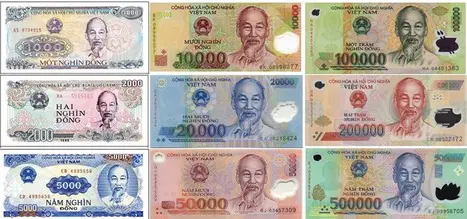
Price benchmarks
Accommodation
- Hostels/guesthouses (dormitory bed): from ~$4–6 (depending on season/neighborhood)
- Single double room: ~300,000 VND (≈ €10–12)
- Mid-range: ~500,000 VND (≈ €16–18+)
- High-end: ≥ 1,800,000 VND (≈ €60–70+)
Meals & drinks
- Cheap local dish: ~50,000 VND (≈ €1.60)
- Coffee (cappuccino type): ~40–45,000 VND
- Local beer (draft): ~25,000 VND (≈ €1)
- Water (small bottle): ~10,000–12,000 VND
Tipping is not mandatory, but appreciated (guides, drivers, tourist restaurants).
Transport
- Motorcycle: ~150,000–200,000 VND/day ($5–8) excluding premium models
- Essence : ~20–21 000 VND/L (≈ 0,75–0,78 $/L)
- Intercity buses: benchmark ~150,000 VND (average journey)
- Urban taxi: short trips ~50–100,000 VND (neighborhood → neighborhood)
For data updated by city (rent, restaurants, groceries…), consult Numbeo (for Hanoi, for example).
Small budget
Average budget
Comfortable
Small budget
Average budget
Comfortable
Small budget
Average budget
Comfortable
Vietnam can be travelled around peacefully provided that a few simple rules are followed: appropriate insurance, health prevention (vaccinations, mosquitoes), food hygiene and caution on the road.
Travel insurance — is it really necessary?
Dedicated insurance covers areas that bank cards don't adequately protect (high medical expenses, repatriation, civil liability, sports/motorcycle accidents, etc.). This is particularly relevant if you ride a motorcycle or are going away for several weeks.
- Compare them care ceilings, repatriation, RC and Franchises.
- Check the motorcycle handling (driver & passenger) and "adventure" activities.
- Keep police + emergency numbers on you and in the cloud.
I recommend you Heymondo Travel Insurance (5% discount via my link).
Transparency: if you subscribe via this link, I will receive a small commission — at no extra cost to you.
Vaccines & health prevention (reminder)
- Up to date : DTP for adults, MMR for children.
Depending on profile & route:
- HEPATITIS A (common in Asia)
- TYPHOID (if eating "street food" in rural areas)
- HEPATITIS B (long stays/possible treatment)
- RAGE (rural stays, contact with animals)
- Japanese encephalitis (long stays in rural rice-growing areas)
- ANTITUBERCULOSIS (special cases)
If you want to do things right, before you leave, consult an international vaccination center for a personalized opinion (history, duration, season, itinerary).
Mosquitoes & Vector-Borne Diseases
- Skin repellent containing DEET/icaridin/PMD ; put some more on in the evening.
- Clothing long (ideally impregnated), mosquito net if basic accommodation.
- Choose rooms air-conditioned/ventilated.
- Malaria : low risk in the city; Chemoprophylaxis to be discussed For some rural/border areas — see a travel doctor.
- Dengue/Chikungunya/Zika : no preventative medication; the mosquito repellent remains the best defense. In case of fever, consult quickly (avoid ibuprofen/aspirin without medical advice).
Hygiene & water/food
- As with children, I would be tempted to remind everyone of a basic rule: washing your hands (or using hand sanitizer) before each meal is never a bad idea.
- Water : in a sealed bottle; you can find it for sale everywhere.
- Meats/fish good cooked fruits peeled by you.
- As everywhere, avoid the water stagnant for swimming.
- Do not pet stray animals (risk of rabies/bite).
Recommended kit: antiseptic, antidiarrheal + oral rehydration, analgesic (paracetamol), mosquito repellent, sunscreen, burn/irritation cream, bandages.
Safety — Traffic, Scams & Natural Hazards
- Two-roues : port of helmet imperative; unpredictable traffic — avoid driving without local experience; favour a reputable rental company and well-maintained motorcycles.
- Personal effects : general rules specific to each country. Keep essentials on you, distribute money in several bags/different places; beware of theft on public transport.
- Scams : check prices before travel/purchase; use official ticket offices for ferries/tickets.
- Sea & boats : in case of rough seas, delays/cancellations; avoid routes known to be rough if you are sensitive.
- Monsoon/Typhoons (depending on the season): follow the local weather forecast and allow extra time in the itinerary.
Emergency numbers & useful contacts
Emergencies in Vietnam
- Police : 113
- Firefighter : 114
- Medical emergencies: 115
Establishments (examples) — Check opening hours/contact details before traveling:
- Hanoi
French Hospital (Đông Đa) — Emergency Department: +84 24 35 74 11 11 - Ho Chi Minh City
FV Hospital (District 7) — +84 28 54 11 33 33 (24/7 emergency services)
CMI (International Medical Center) — +84 28 3827 23 67
French Embassy — Hanoi
57 Trân Hung Đao — Tel. : +84 24 3944 57 00 (consular emergency)
Travel advice from the Ministry of Foreign Affairs (France Diplomacy) : Vietnam fact sheet


